Background on Boulder’s Public Art Program:
Boulder’s Public Art Program was created in 2018. Before that, the city did not have a cohesive program or a guiding public art policy. Some of Boulder’s public art from before 2018 was donated or loaned to the city, often with unclear terms (we’ll talk about this later on the tour). Some were purchased by city departments, such as Parks and Recreation and Transportation, each with its own policy (or lack thereof) for acquiring, maintaining, and cataloguing public art. Each piece was handled differently. Since the implementation of the first Public Art Policy in 2018, the Office of Arts and Culture has begun the task of auditing and organizing all the works that the city considers “public art.”
Public Art vs. Urban Design. What we have found is that while many of the works are indeed public art, many we are considering “urban design” because there is no artist named, or an artist or designer assisted with the overall aesthetic of the project (such as a bridge or underpass) but there is no “work of art” created by them. Our goal is to clarify this process and eventually begin maintaining and showcasing our public art collection to residents of and visitors to Boulder.
1% for Art Policy. 1% of any capital improvement project with a construction budget of over $100,000 qualifies for public art. The city takes 1% of the construction budget and goes through a very specific process to commission new work that will be integrated into the larger project. For example, imagine the City is building a new park and the construction budget for the new park is $1M. Our program would get $10,000 to spend on new, site-specific artwork for that new park. We always create an art selection panel that includes community representatives and an artist and arts professional. We post calls for art and artists apply with images of their past work, a resume, and a short narrative about why they’re interested in the project. From this group, the panel selects three to create proposals (which we pay for). Then after reviewing the proposals, interviewing the artist, and consulting with project managers and other city staff, a selection is made. This decision is ratified by the Boulder Arts Commission and the City Manager.
Sign up for our newsletter. Get the latest news about what's going on at the Office of Arts and Culture and learn more about public art in Boulder! Sign up here (Office of Arts and Culture Newsletters | City of Boulder).
Get involved. You can sign up to serve on the Arts Commission (selected by Boulder City Council), or to serve on an art selection panel if the project is near where you live. We always appreciate folks letting us know if they see an artwork that needs cleaning or repairs. Please check out our website (Public Art | City of Boulder) for more info.
Tag us on social media. We’d love to see your photos from the tour! Tag us @boulderartsculture on Instagram and Facebook.
Start at 17th & Pearl at Los Seis sculpture
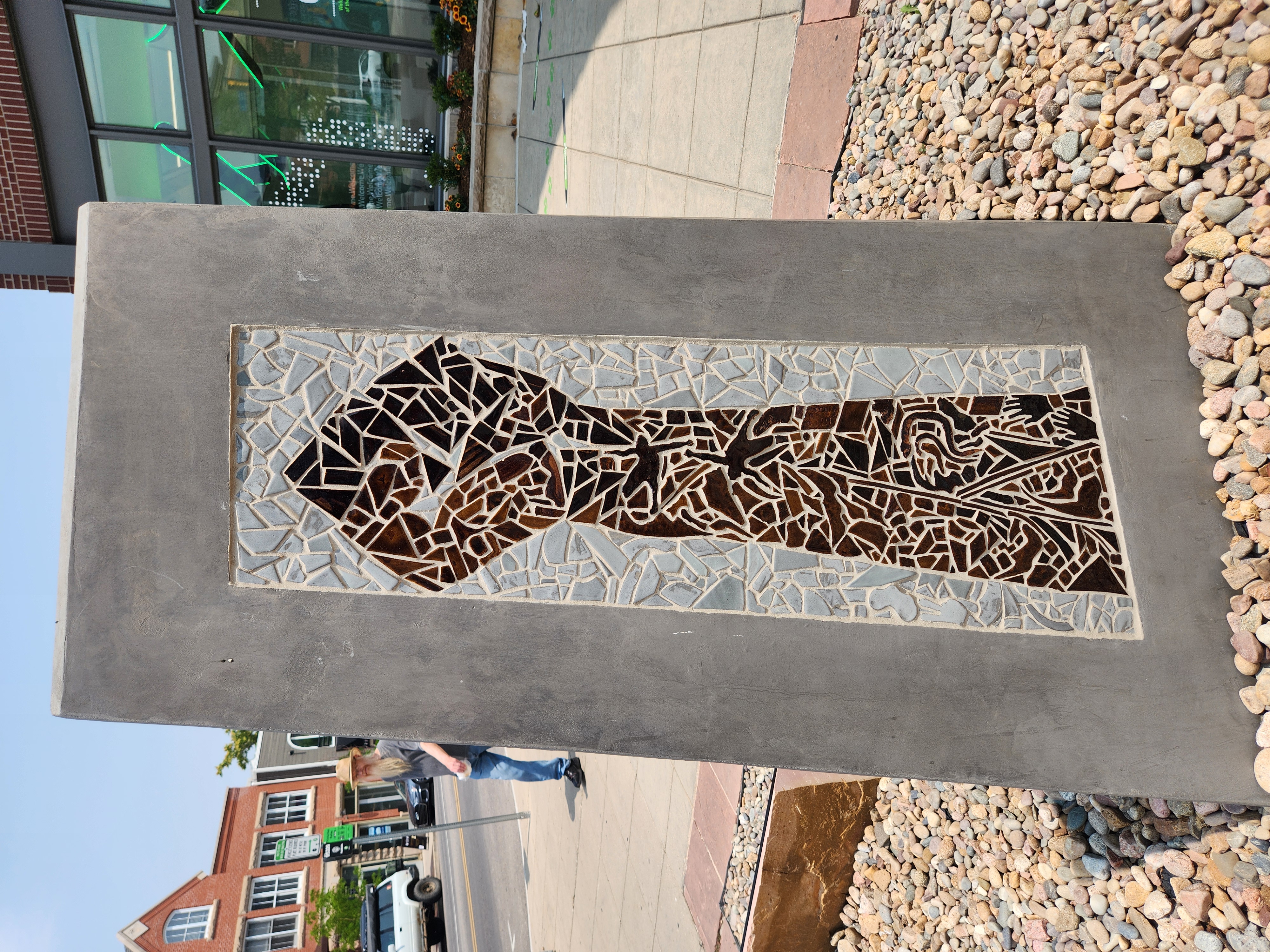
Title: El Movimiento Sigue
Artist: Jasmine Baetz
Installation date: 2024
Materials: Concrete, ceramic tiles
Location: 17th & Pearl
This memorial honors Los Seis de Boulder, six Chicano activists and students killed in two car bombings in Boulder, Colorado in 1974. The name Los Seis de Boulder was coined posthumously. The mosaic is inspired by Juan Espinosa’s 1973 photographs of a Black Student Alliance protest supported by United Mexican American Students at CU Boulder, reflecting solidarity among BIPOC students.
In early 2019, students at CU Boulder along with community members and surviving family members created a sculpture with portraits of each of the students (and alum) who died, that was installed in front of Temporary Building 1 on campus. In 2020, many of the same participants created this second sculpture, which was eventually installed here in 2024. The tiles in this work were made by hundreds of hands and laid by artists Jasmine Baetz and Carlos Sandoval.
The site of the student occupation at Temporary Building 1 on CU Boulder campus was marked with a tile mosaic sculpture in 2019. The site of the first bombing, at Chautauqua Park, was marked with a stone inscription in 2020. This work was originally intended for the corner of 28th St. and Canyon Blvd., the site of the second bombing, and so its inscription refers to that site, one mile east of here. It is installed here at the center of town, reflecting the centrality of Los Seis to the history of Boulder, and the City of Boulder’s commitment to remembering Los Seis de Boulder.
Start walking west down Pearl St. towards 16th St.
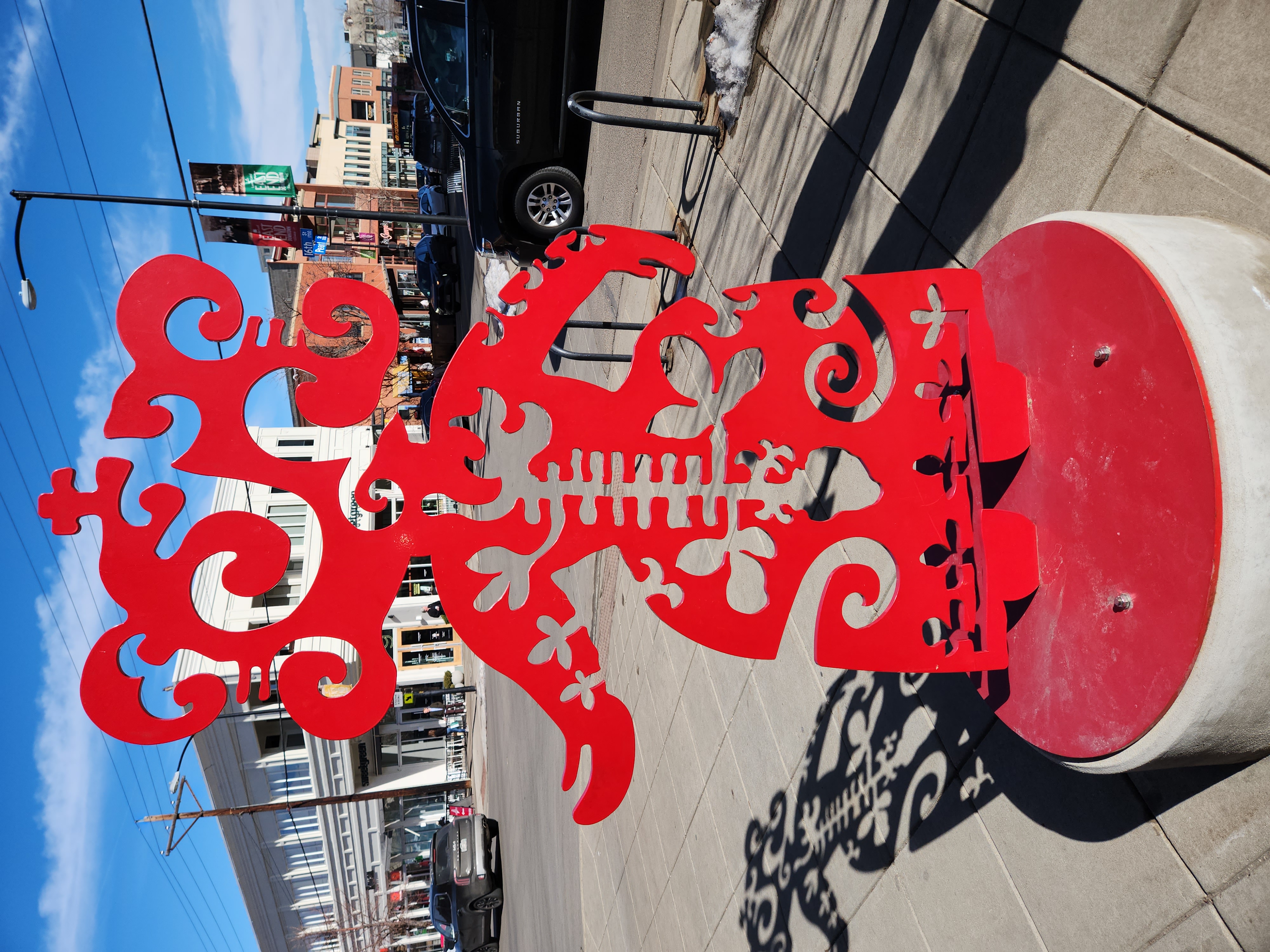
Title: Strength from Within
Artist: Melanie Yazzie
Installation date: 2020
Materials: Powder-coated steel
Location: 16th & Pearl (in front of Organic Sandwich Co.)
This powder-coated steel sculpture symbolizes the strength existing within oneself needed to heal, survive, and to carry on in life. When reflecting upon Strength from Within, Dine (Navajo) artist Yazzie described the work as “a self-portrait of my state of mind when I am working on fixing things from inside myself.” When conceptualizing the sculpture, she drew upon the experience of returning to health after being in a head-on collision with a drunk driver in 1997.
Melanie Yazzie sees her position as an artist to be an agent of change and to inspire communities to improve societal conditions. She also uses this position to engage with the histories that affect Native peoples today. In an interview for the VoyageDenver magazine artist spotlight, Yazzie describes how Diné “are taught to seek out beauty and create it with our thoughts, action, and prayers.” Yazzie’s art originates from her Diné identity, and each work responds to personal experiences and life events. The artworks are also thought-provoking commentaries on the daily struggles of Native communities.
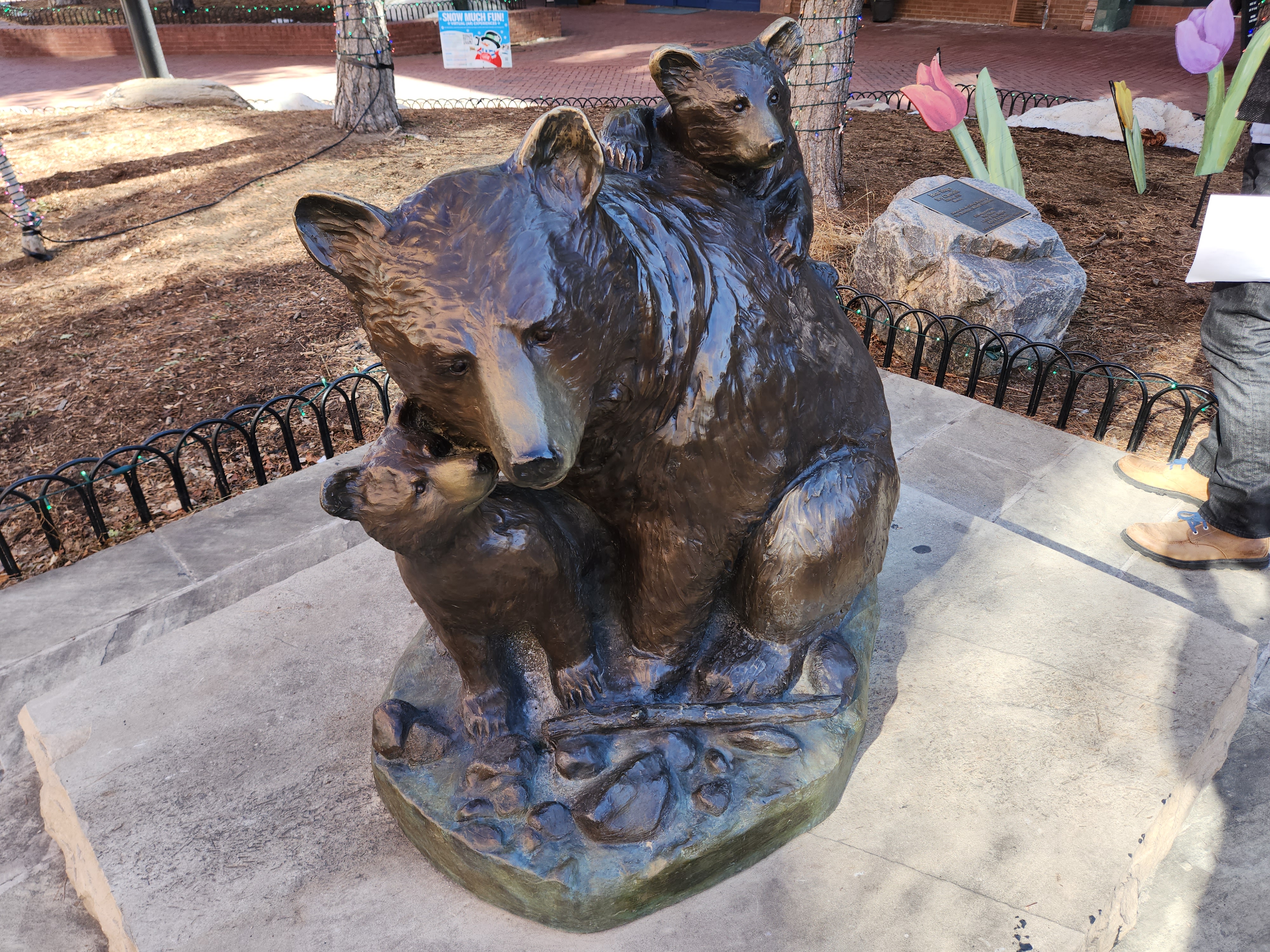
Title: Bear Hugs
Artist: Scy Caroselli
Installation date: 2019
Materials: Bronze
Location: 15th & Pearl in front of Illegal Pete’s
Nestled into a raised brick planter is Bear Hugs by Scy Caroselli, installed in 2019. Originally crafted in 2016 as one of ten castings, the group sculpture portrays a tender moment between a mama bear and her playful cubs. This Italian-inspired masterpiece invites interaction and unforgettable photo opportunities for all who encounter its charm.
Scy Caroselli’s artistic journey began later in life after serving as an art agent. Scy embarked upon her sculpting career due to the encouragement of her mother, Marianne Caroselli, a prolific sculpture artist. Scy’s training in Italy and across the United States coalesces into whimsical, detailed sculptures that continue to captivate global audiences. Bear Hugs showcases her mastery of bronze-making, echoing the talent that runs through her family lineage.
The Downtown Boulder Foundation generously donated the sculpture to the City of Boulder, accessioning the work to the Public Art Program’s collection. For years to come, mall goers can embrace the magic of Bear Hugs, where artistry meets emotion in a timeless celebration of family and nature.
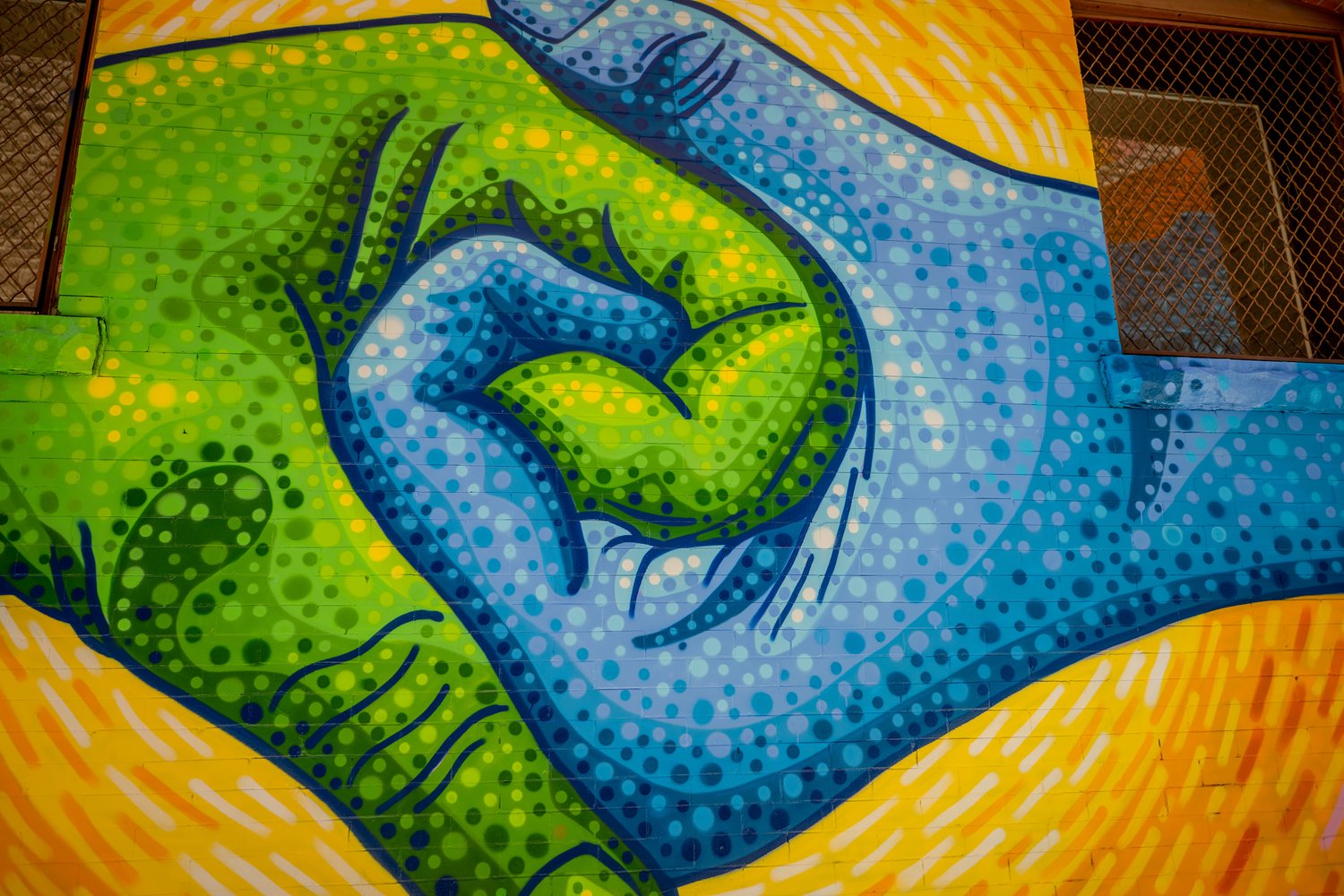
Title: Green Harmony
Artist: Austin Zucchini-Fowler
Installation date: 2022
Materials: Paint
Location: 1400 block Pearl St. Mall (next to Pedestrian Shops)
Just beyond Bear Hugs in a nearby side alley is Green Harmony, a mural painted by Austin Zucchini-Fowler during the 2022 Street Wise Mural Festival. Fowler’s entrancing kaleidoscopic color palette provides the basis to represent his vision of harmony with the earth, realized through embracing renewable energy sources.
Green Harmony features the Greek mythological character, Gaia, a personification of earth, who serves as one of the fundamental deities of our world. Expanding across the alley walls are realistic or more whimsical renderings of green energy, such as a dam pouring forth water onto the sidewalk and windmills with Colorado’s state flower, Columbine, as the turbine blades.
To bring his vision to life, Fowler employed the 19th century pointillism technique, which involves using small, distinct dots of color to create the composition. Although murals are one of the most popular public art forms, these 2-D works are technically temporary and are not a part of the city’s public art collection. However, they are still worth mentioning!
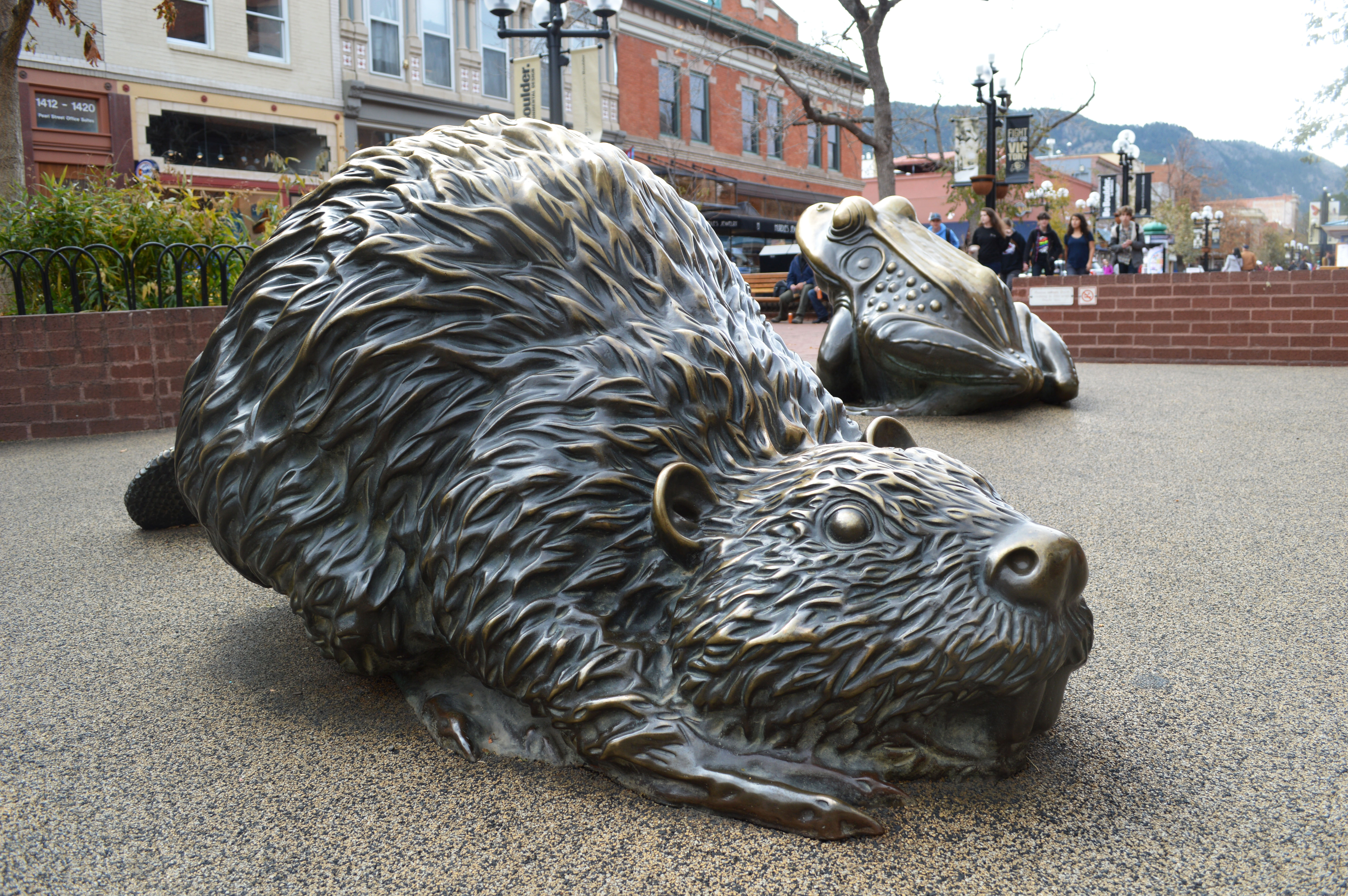
Title: Snail, Rabbit, Frog, Beaver
Artist: David Sosalla
Installation date: 1977 (the year of Pearl Street Mall’s dedication)
Materials: Bronze, marble
Location: 1400 block of Pearl St. Mall
Step into the enchanting world of David Sosalla's timeless, larger-than-life sculptures, located just to the left of Green Harmony. In 1977, Boulder’s mayor Frank Buchanan unveiled Rabbit, Frog, Beaver, and Snail during the Pearl Street Mall’s grand opening ceremony. Carved from exquisite marble or cast with glistening bronze, Sosalla’s animal sculptures embody a breathtaking naturalism with a hint of make-believe, bringing joy to visitors of all ages.
David Sosalla's journey as an artist began at the University of Colorado, where his passion for sculpting blossomed and later propelled him into national recognition in the film industry. His special effects contributions to iconic films such as "Star Wars: The Return of the Jedi" and "Indiana Jones and the Temple of Doom" reveal his artistic versatility beyond traditional sculpture. Sosalla’s accolades include the prestigious British Academy Award in 1989 for his contributions to "Honey, I Shrunk the Kids." Although Sosalla retired from the film industry to his California estate in 2010, he continues to pursue his passion for the arts by painting, sculpting, and etching. His art reflects a lifelong dedication to crafting narratives that capture the relationship between nature and human emotion.
Boulder City Council chose Sosalla, because they wanted artworks relatable to any passerby. The larger-than-life sculptures beckon to be touched, revealing intricate details that blur the line between art and reality. Although the artworks are not a part of the collection, the Public Art Program is working towards adopting each figure to ensure that the works grace the Pearl Street Mall with their endearing presence for many years to come.
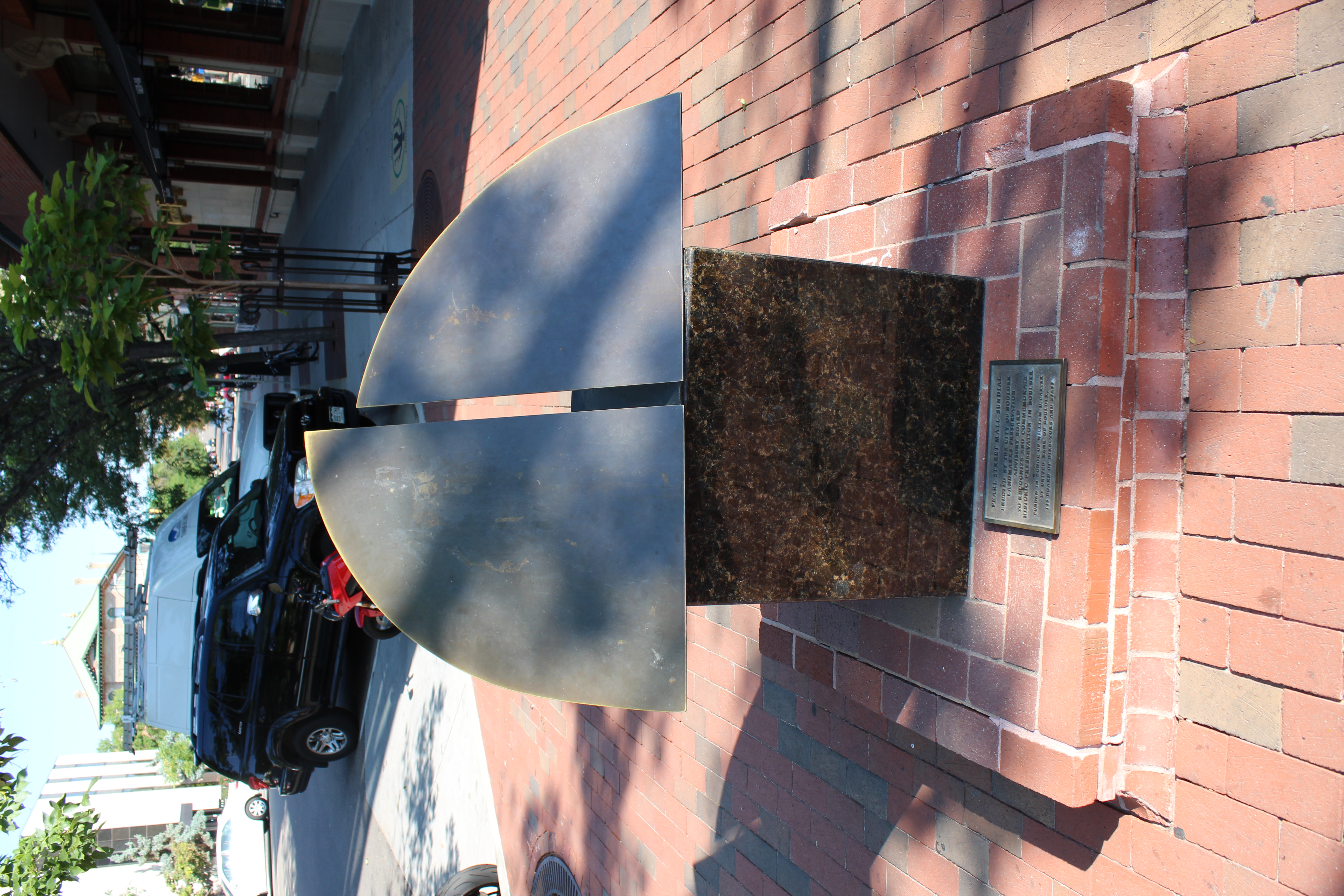
Title: Sundial
(URBAN DESIGN)
Installation date: 1983
Materials: Bronze
Location: 1400 block of Pearl St. Mall
To your right, Pearl Street’s bronze Sundial glistens in the sunshine with its weathered patina. The City of Boulder Landmarks Preservation Advisory Board installed Sundial in honor of William D. Carter. Bill Carter, a longtime Boulderite, was the president of the United Bank of Boulder in the 50s and 60s. This banking institution, formerly known as the Mercantile Bank and Trust Co., first established its presence along Pearl Street in 1913 with the city’s first ever fireproof structure at 1201 Pearl Street.
Dedicated in 1983, Sundial features a 60 cm brass plate gnomon (timekeeping device) with a centered slit. The slit allows light to fall on the inscribed hour lines beneath the plates, indicating the time of day. Sundial is not a part of the Public Art Collection, because the work has no associated artist. Instead, the work is considered urban design, defined as:
“Objects not created intentionally as artworks and/or demonstrated to be intentionally displayed as artworks may be considered urban design elements. Objects created with the intention to enhance public spaces and the infrastructure of that space may be considered Urban Design. Things like seating, lighting, way finding, and sidewalk treatments are all examples of Urban Design elements.”

Title: Boulder County Courthouse Sculpture Garden
Location: 1300 block of Pearl St. Mall
To your right is the Boulder County Historic Courthouse, a cornerstone of Boulder's rich history. Take a moment to appreciate the intricate details of its Art Deco architecture. Constructed in 1933, the courthouse is a prime example of this distinctive style, characterized by its geometric forms and symmetrical patterns.
The courthouse not only serves as a center of legal proceedings but also stands as a beacon of progress and inclusivity. In 1975, long before same-sex marriage was legally recognized nationwide, Boulder County Clerk Clela Rorex issued the first gay marriage license in the United States here. This groundbreaking event wedded two men from Colorado Springs and marked a significant step forward in the fight for LGBTQ+ rights.
The plaza and lawn in front of the courthouse features a sculpture garden dedicated to the memory of those who served in the Civil War. The sculpture garden is owned by Boulder County (not the city) so although it is not technically part of the City of Boulder’s Public Art program, it’s worth checking out!
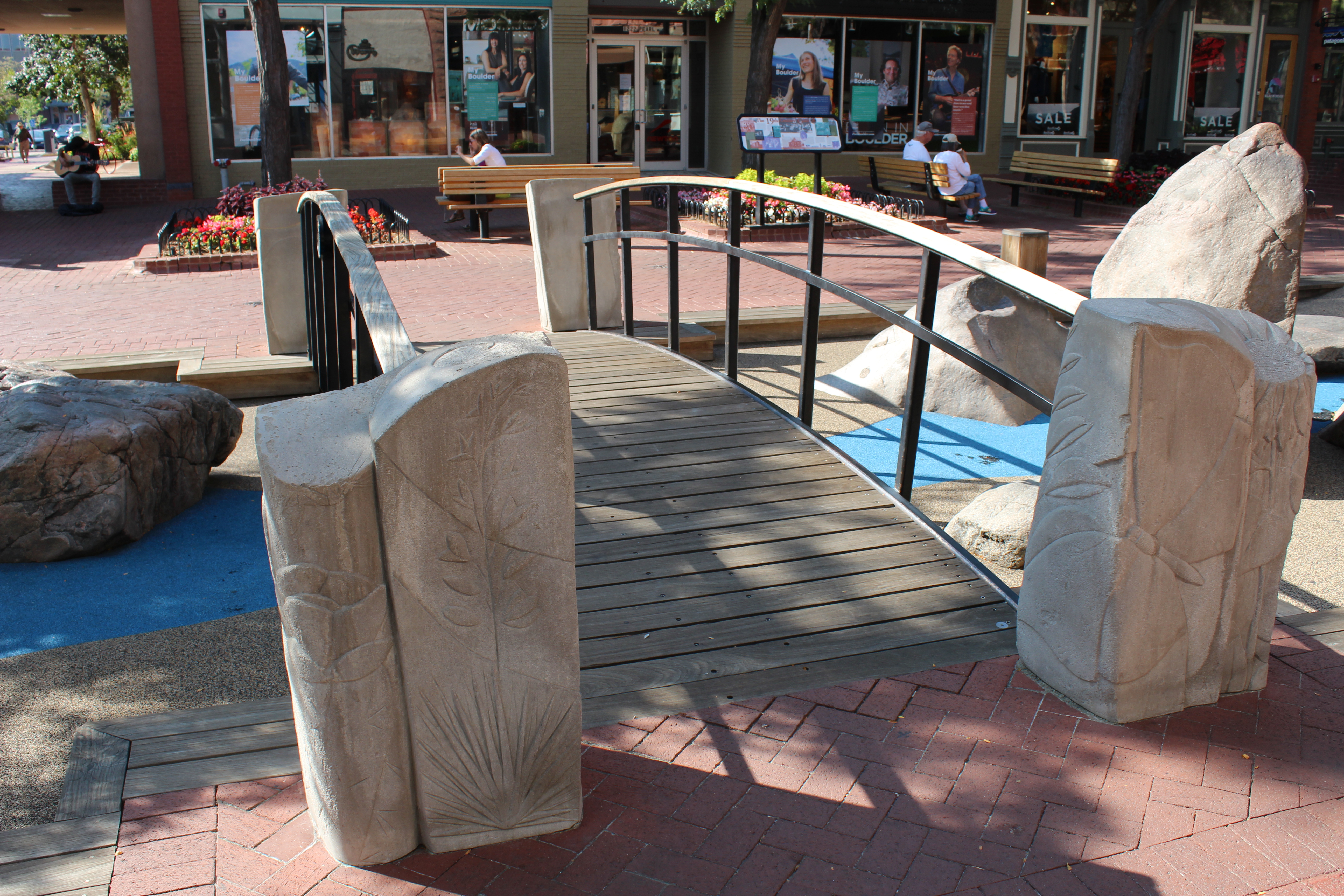
Title: Little Bug Bridge
Artist: Julie Maren
Installation date: 2002
Materials: Limestone
Location: 1200 block of Pearl St. Mall
Up next is Little Bug Bridge, designed by local sculptor, Julie Maren. Little Bug Bridge captures the essence of Boulder’s surrounding wildlife and plant life. Each sandstone pillar depicts a variety of local flora, including mariposa lily, yucca, prickly pear cactus, cattails, mountain sunflower and wild grasses. Maren also rendered crickets, monarch butterflies, dragonflies, and honeybees on the pillars. These insects visited her during the summer of 2002 while designing the bridge. Inspiration arose from long walks in the meadows, mountains, and marshlands of Boulder.
This bridge resulted from Pearl Street Mall’s 2000 redesign plan involving updated walkways, raised brick garden beds, and a new bridge over the children’s rock play area. Maren’s bridge is considered urban design due to its purpose to improve the mall’s infrastructure.
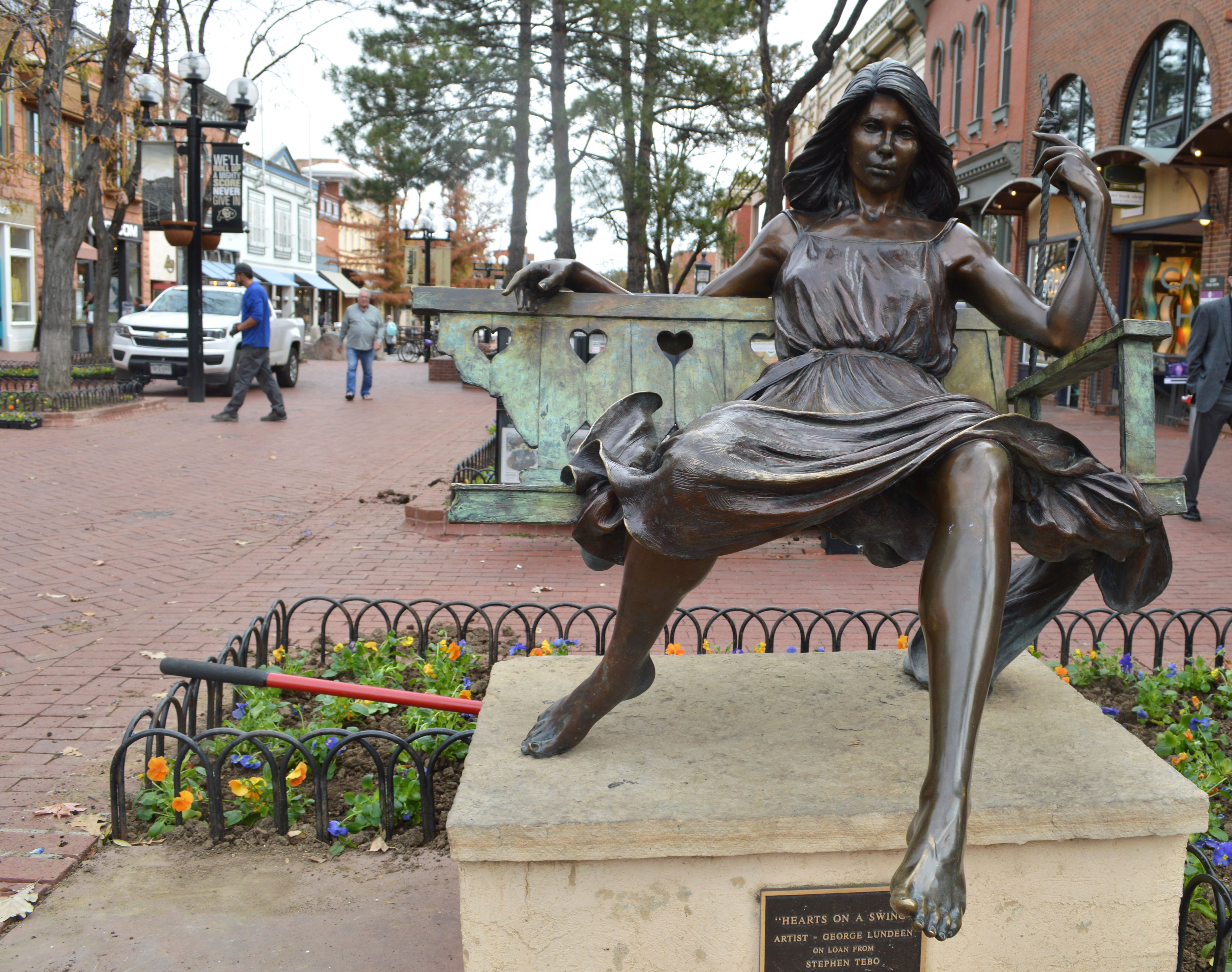
Title: Hearts on a Swing
Artist: George Lundeen
Installation date: 1988
Materials: Bronze
Location: Broadway & Pearl
The sculpture, Hearts on a Swing, features a woman cast in bronze sitting atop her fragmented bench. In the design process, George Lundeen chose to place the swing’s rope on the back left to signify its purpose. As an ode to the sculpture’s title, Lundeen designed hearts into the swing’s bench slats using negative space. Lundeen cast the dress to mimic wind sweeping through the folds of the woman’s dress while she casually rests against the bench with her right arm draped along the back. As the woman relaxes into the bench, she playfully swings her left leg out from underneath the draped fabric.
Hearts on a Swing embodies the care and attention that George Lundeen gives to his bronze sculptures. Lundeen, a native to Holdrege, Alaska, slowly gained prominence as a noted sculptor through his time studying at Accademia di Belle Arti in Florence, Italy. Lundeen later set up his practice in Loveland, Colorado where he continued to gain recognition for his work. Lundeen’s fascination with human emotion inspired his passion for animate subjects, both human and animal.
This is an example of a privately owned work of art residing in public space. The City does not own this work, it is on “long-term loan” from property owner and developer Stephen Tebo. We have no record of this loan or how long it was intended to last. This piece may stay here into the indefinite future.

Title: Metamorphic Rock I
(URBAN DESIGN)
Installation date: 2002
Materials: Migmatitic rock
Location: 1100 block of Pearl
Just beyond the sandstone bridge is a visual reminder of the origins of Boulder’s name: Metamorphic Rock I. This severed boulder located on an elevated platform celebrates[RD1] the geologic wonders located in and at the outskirts of Boulder.
Metamorphic Rock I is a gneissic migmatite rock formed in the Proterozoic era about 1.7 to 1.8 billion years ago. Migmatite forms much of the deep crystalline “basement” of Colorado. It is composed of several minerals: biotite and muscovite mica, quartz and plagioclase and alkali feldspar, the latter providing the distinctive pink color. Before splitting, these rocks were originally the greater portion of the third rock located 100 feet to the west at 11th street. Each of these halves weigh about 15 tons and were cut using a diamond bit quarry wire saw. The original boulder was found outside of Fairplay, Colorado and installed on our mall in 2002. Passersby can admire the thermally softened veins as they walk between the two halves of the severed boulder.
This piece is another example of urban design, purposed to add beauty to the city’s infrastructure.
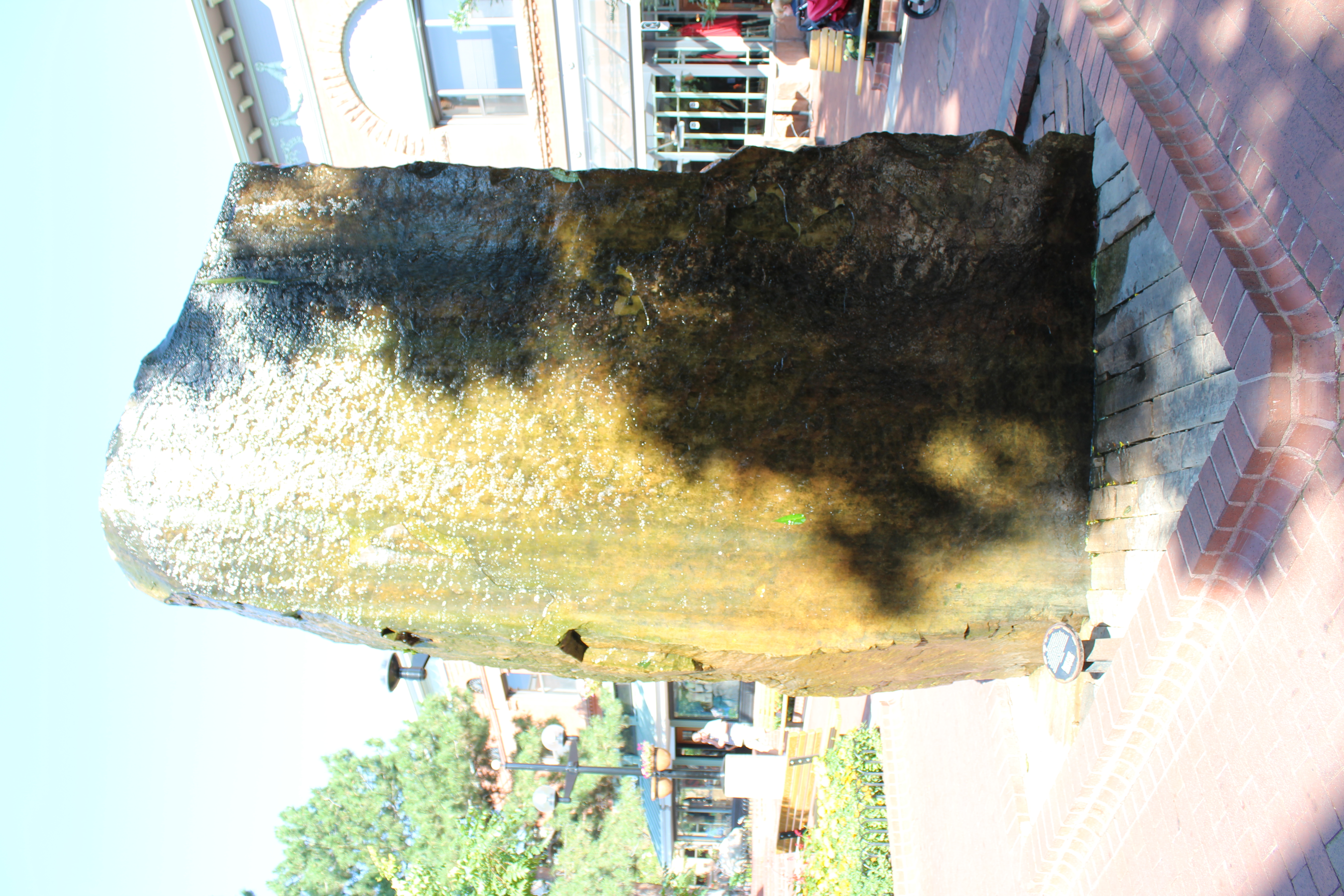
Title: Sandstone Fountain (“The Weeping Rock”)
(URBAN DESIGN)
Installation date: 2002
Materials: Sandstone
Location: 1100 block of Pearl
Just beyond and to the left of Metamorphic Rock I is Sandstone Fountain or “The Weeping Rock,” another example of urban design. Boulder’s Parks and Recreation department installed the fountain to add more natural elements to the Pearl Street Mall. Though beautiful, the fountain was not created by an artist and is thus not a part of the Public Art Program.
The fountain is often the site of improvised, temporary art installations: mall-goers use the fountain’s wet surface to plaster petals and leaves into mandala or floral compositions. The plant material easily adheres to the surface and remains vibrant and well-preserved due to the constant moisture. Keep an eye out for sporadic compositions still appearing today.
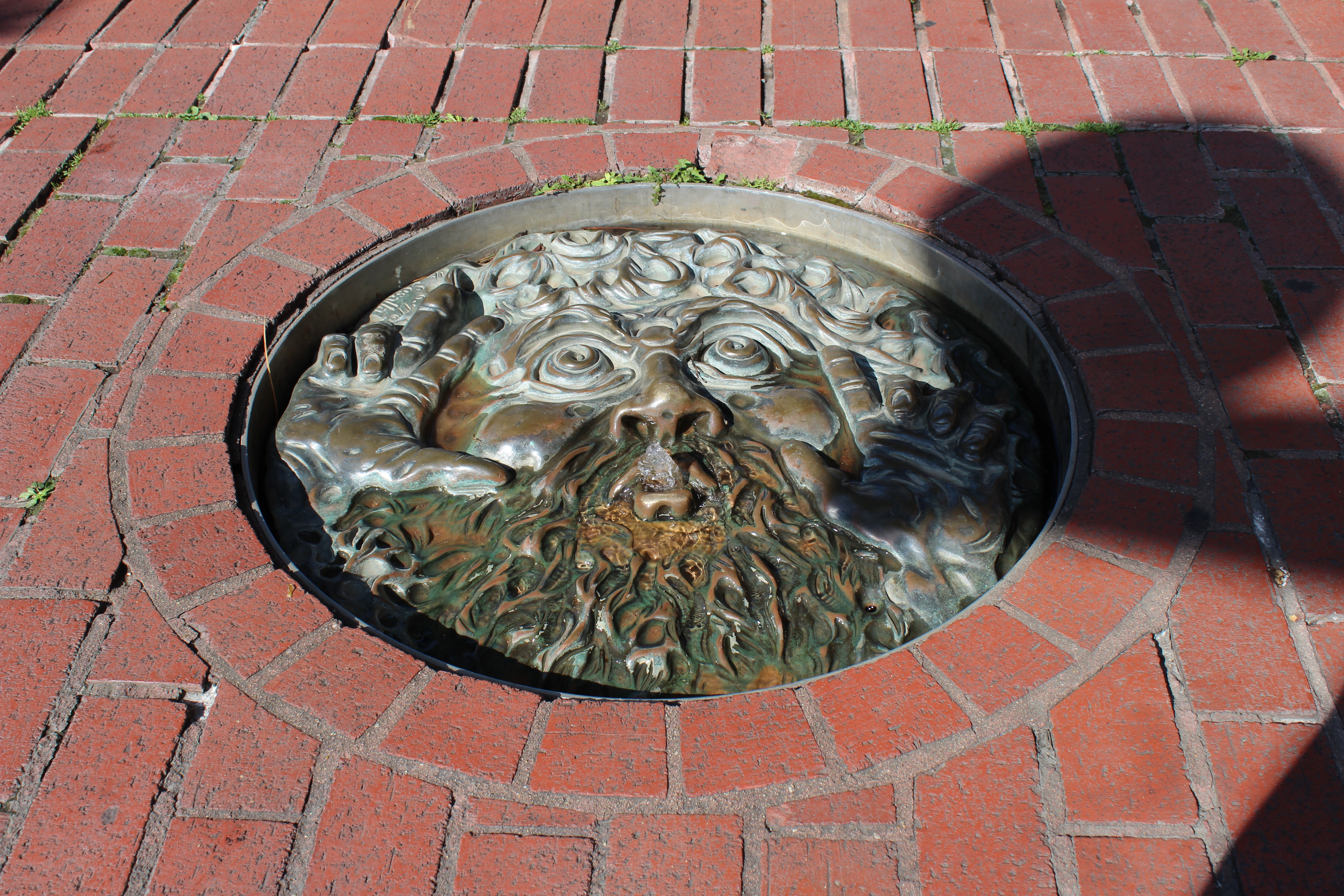
Title: Face Fountain
Artist: David Sosalla
Installation date: 1977
Materials: Bronze
Location: 1100 block of Pearl
Just beyond the Weeping Rock is Face Fountain, located in the corner of a raised brick garden bed. This bronze fountain is the fifth commissioned piece installed in 1977 by David Sosalla. Sosalla signed his name along with “6-77” into the bronze sculpture along the outer top left portion of the man’s head, amongst his curly, flowing locks.
During Boulder’s summer months, water can be seen gushing from the wide-eyed man’s puckered lips. The exposure to water and sun has caused the bronze to fade into a deep, dark brown with hints of aqua and dark green, seen in the wrinkles of his face and hands.
Due to the bronze’s early installation date, the artwork does not belong to the Public Art Collection. However, the Public Art Program is working towards adopting this piece by Sosalla to ensure that the whimsical artwork graces the mall for years to come.
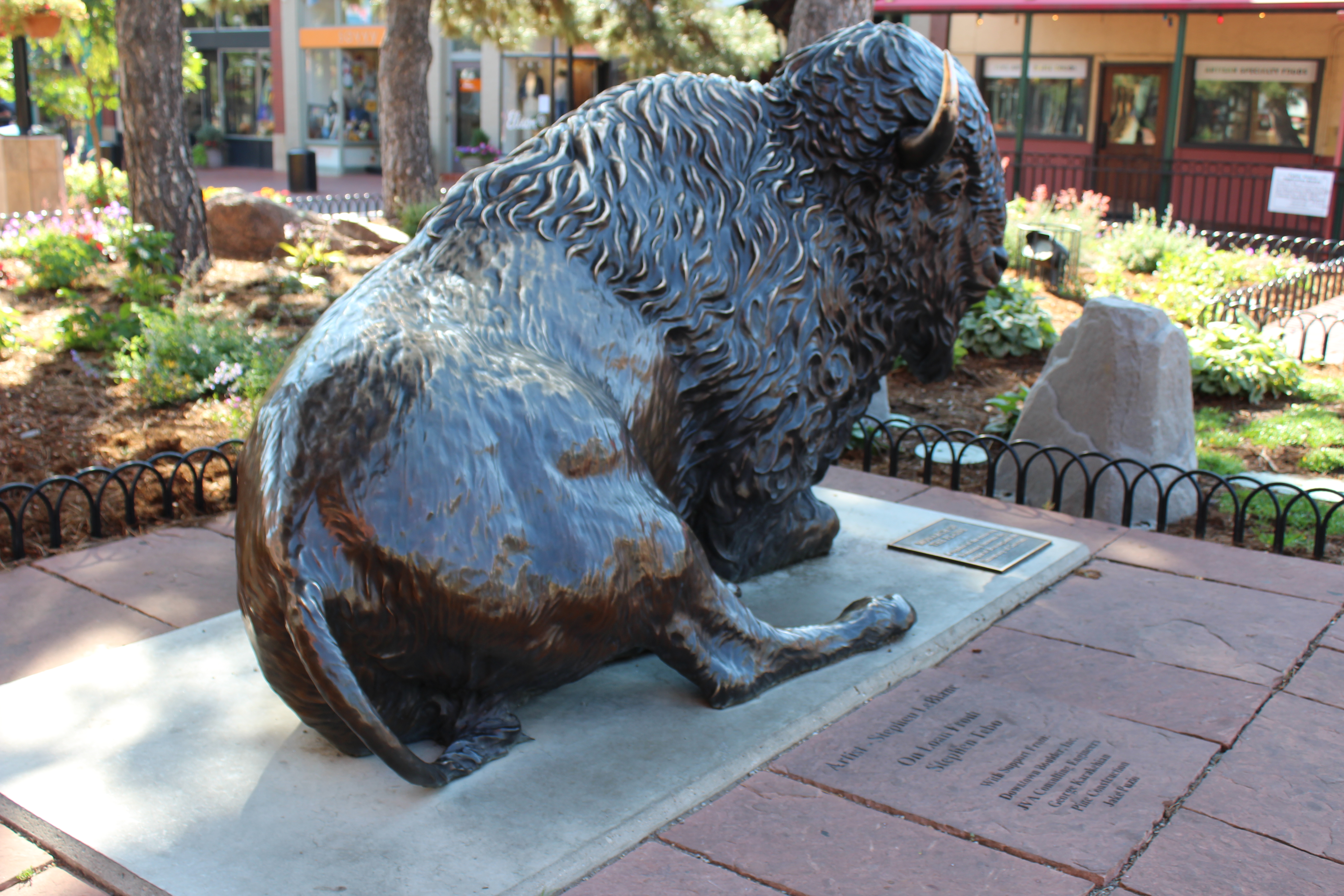
Title: Monarch of the Plains
Artist: Stephen LeBlanc
Installation date: 2015
Materials: Bronze
Location: 11th & Pearl in front of Billabong
Just around the corner from Face Fountain on the same raised brick planter is the majestic Monarch of the Plains created by New Mexico artist Stephen LeBlanc. This striking addition to Boulder's vibrant public art scene is not in the Public Art Collection, because the artwork is a long-term loan from Stephen Tebo. The bronze bison, standing at 50” tall and 90” in length, surveys passersby from its perch on the Pearl Street Mall. If the bison were standing upon its legs, it would reach the height of a bull which averages at 72” tall and can weigh between 1,800 and 2,400 pounds.
Ever since his childhood, LeBlanc’s passion for the outdoors has continued to inspire his creations. LeBlanc captures the anatomy and spirit of his subjects through his realistic portrayals. The name, monarch, evokes the grace, beauty, and swift nature of the animal that has historically roamed the Colorado plains. A plaque on the concrete foundation reads, “Monarch of the Plains: A symbol of the enduring friendship between the people of Boulder and the University of Colorado.”
The first Monarch of the Plains statue to arrive in Boulder was installed in 1995 on the University of Colorado Boulder campus. This version is located near the entrance of the university’s Folsom Field. As a CU Boulder tradition, fans rub or grip either statue’s horns before a football game for good luck. Due to the contact of numerous hands, the horns now feature a golden sheen that contrasts with the original dark brown coloring of its body. The statues remain as good luck charms for both the city and the university.
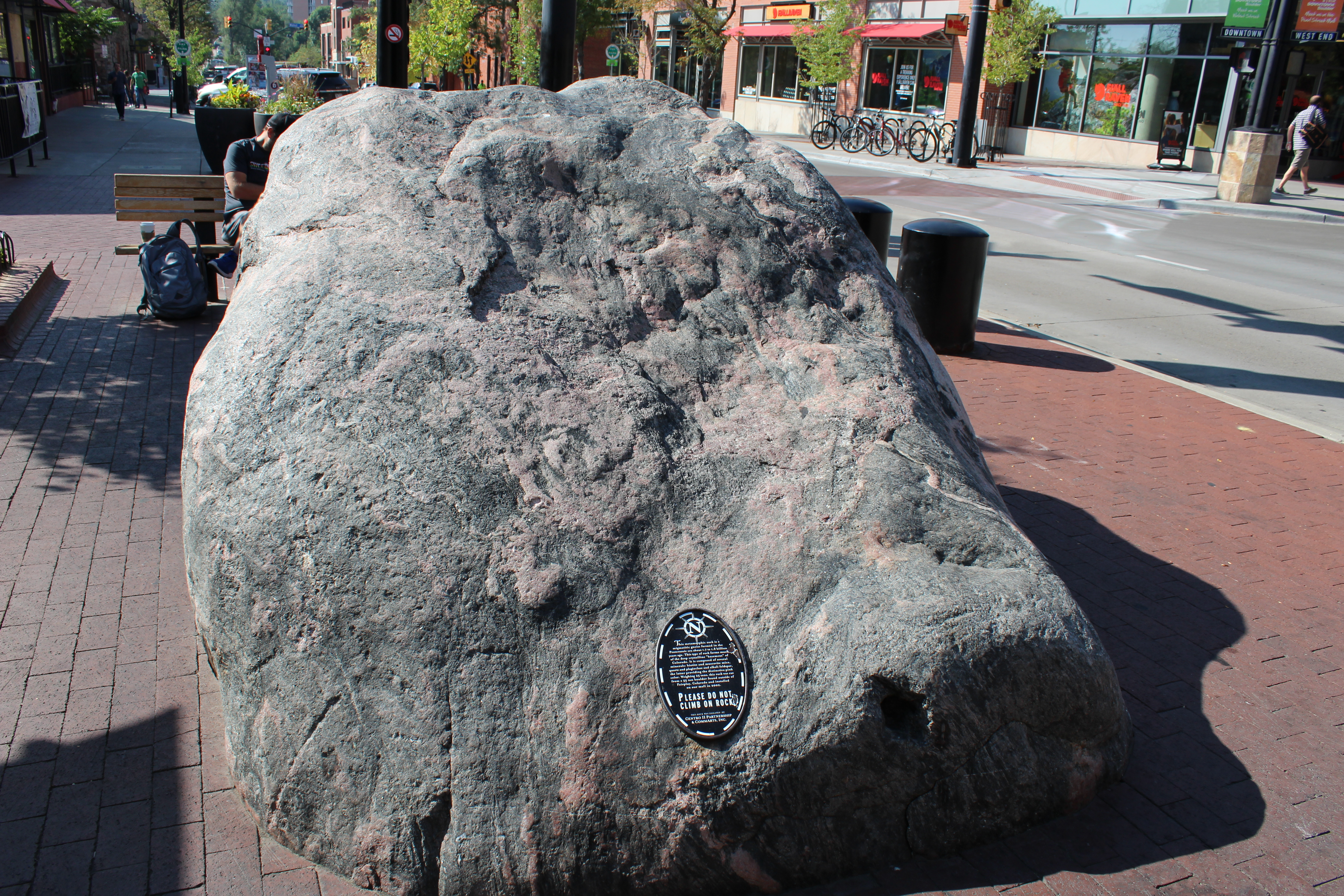
Title: Metamorphic Rock II
(URBAN DESIGN)
Installation date: 2002
Materials: Migmatitic rock
Location: 11th & Pearl in front of Billabong
Here's the other half of the split boulder we walked through just a few minutes ago!
Walk to 9th & Pearl, turn left down 9th St
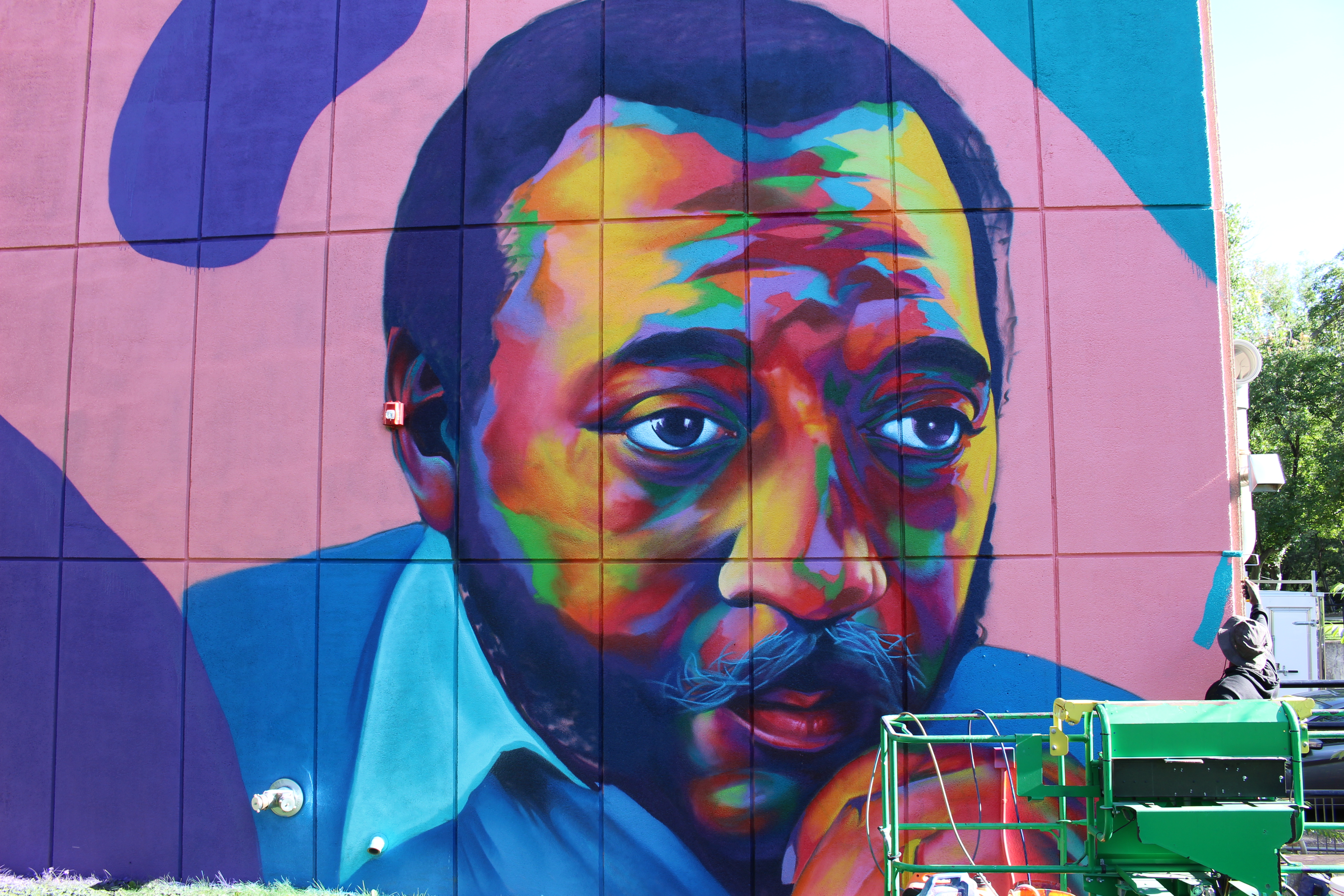
Title: Penfield Tate Mural
Artist: Detour
Installation date: 2020
Materials: Paint
Location: North side of Boulder Public Library
Visible along the intersection of 9th St. and Canyon, the vibrancy of the Penfield Tate II mural invites onlookers to gaze at the portrait of Boulder’s first and only black mayor. Commissioned in 2020, following a resolution on race equity by Boulder City Council, artist Thomas "Detour" Evans was chosen to celebrate and memorialize Tate and his impact on local politics and civil rights.
Penfield Tate II is fondly remembered as a trailblazer in local politics. During his mayoral term beginning in 1974, Tate advocated for equality and supported humanitarian efforts. He focused on the civil rights of underrepresented communities, including Black, Indigenous, People of Color (BIPOC) as well as the local LGBTQ community. His efforts culminated in the controversial human rights ordinance that led to his failure to be reelected. After his mayoral term, Tate continued his legal practice, establishing various firms, with his last being Tate & Tate – a partnership between Penfield Tate II and his son, Penfield Tate III.
In 2020, Boulder also chose to honor Penfield Tate II by renaming the municipal building after him. The mural is not a part of the Public Art Collection due to the impermanent nature of paint and the constant exposure to weather at its location on Boulder Public Library’s north wall.
Cross Canyon to Haertling Sculpture Garden
The Charles A. Haertling Sculpture Park:
Welcome to Boulder’s first and only sculpture park! The park was created in 1984 to honor architect Charles Haertling. Haertling moved to Boulder in 1953 to teach and work as an architect. He designed more than forty buildings around Boulder and was elected to city council and held the position of Deputy Mayor in the 1960s. His son, sculptor Joel Haertling, still lives in Boulder. His piece “Continuous Form” is part of Boulder’s public art collection and is on display at Scott Carpenter Park.
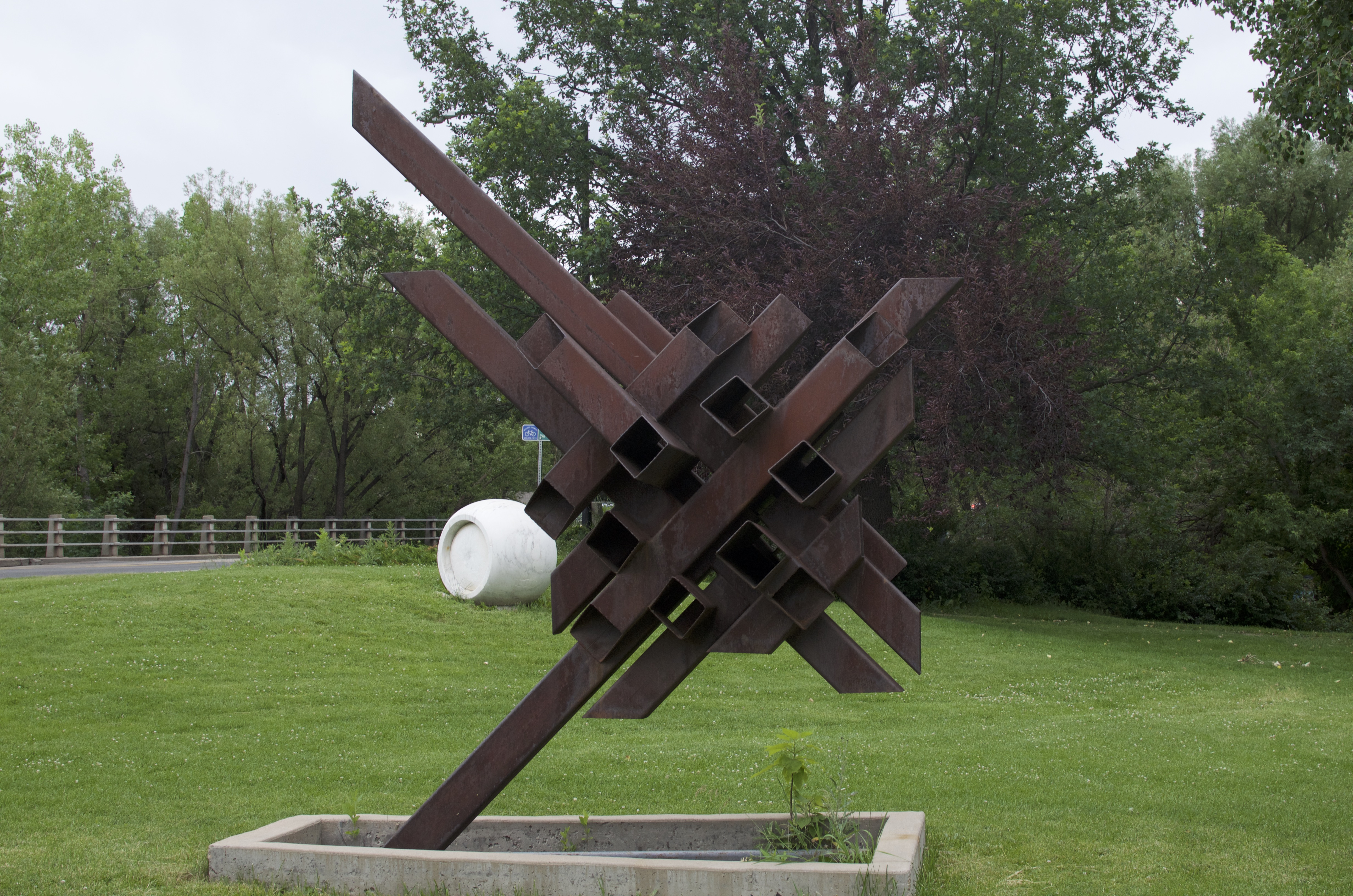
Title: Untitled
Artist: Robert Mangold
Installation date: 2002
Materials: Cor-ten steel
Location: Haertling Sculpture Gallery
When entering the Charles A. Haertling Sculpture Garden, you may first discover the mesmerizing geometry of Robert Mangold's untitled sculpture, a striking focal point in Boulder's Civic Area. Crafted from durable corten steel, this masterpiece embodies Mangold's iconic minimalist style, celebrated for its precision and mathematical creativity. Over time, the sculpture's weathered steel has transitioned into a deeper and richer reddish-brown patina.
Mangold's artistic vision challenges conventional boundaries with the intercrossing, angled bars that appear to defy gravity. The composition creates an illusion of weightlessness as the sculpture elegantly leans to the side. As a pivotal figure in the mid-century minimalist movement, Mangold's work continues to resonate with timeless simplicity and profound spatial exploration. Although he was primarily based in Denver, Mangold received global commissions, exhibiting his work at art institutions in Spain, Mexico, and Japan. The Public Art Program seeks to accession the sculpture, generously donated to the City of Boulder by BMoCA, to ensure that Mangold’s artistic legacy remains for years to come.
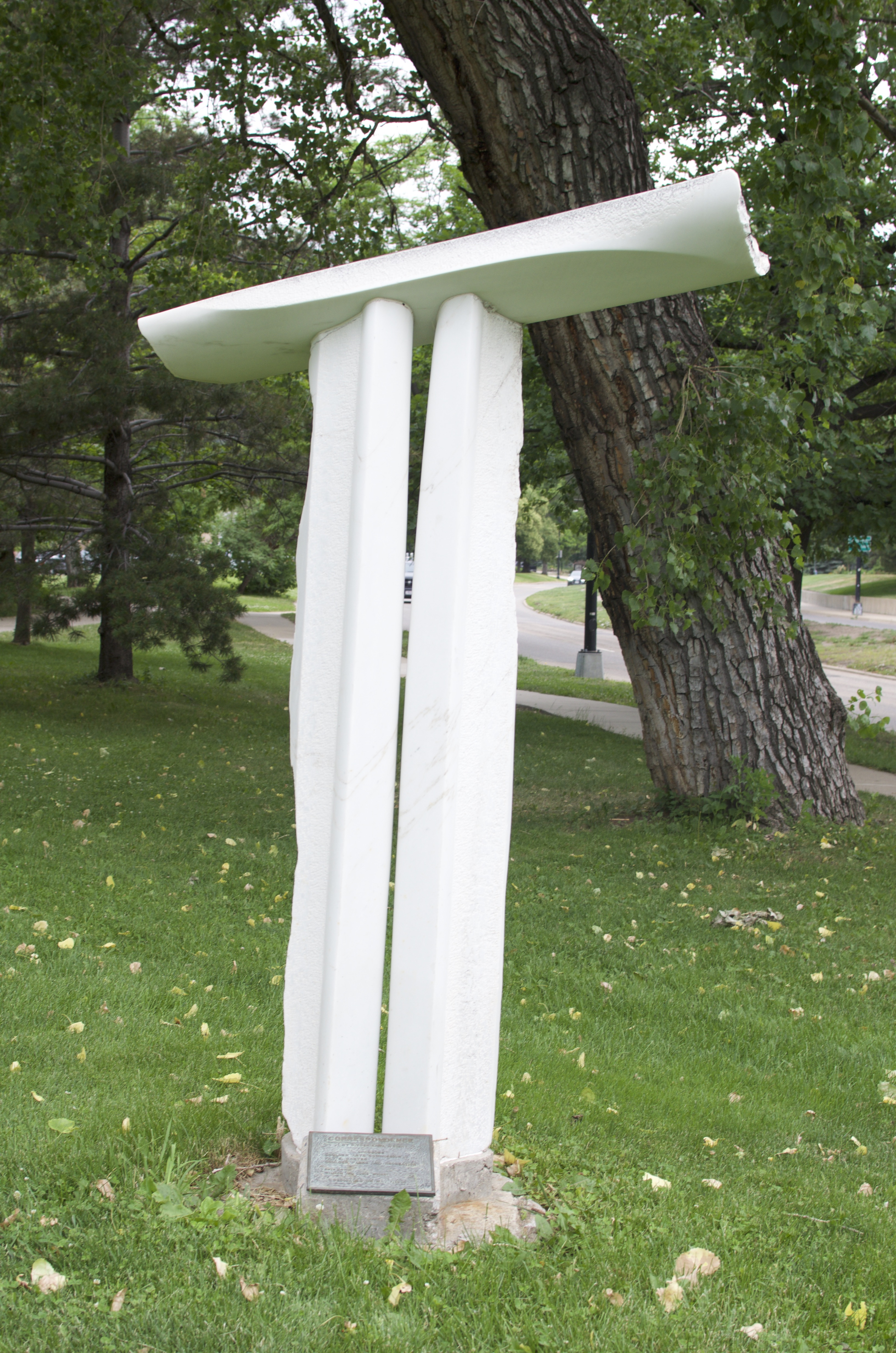
Title: Correspondence
Artist: Dennis Yoshikawa Wright
Installation date: 1986
Materials: Marble
Location: Haertling Sculpture Gallery
Towards the edge of the sculpture garden is the serene Correspondence by University of Colorado Boulder alum, Dennis Yoshikawa Wright. Created in 1985, this piece intricately balances three beams: a gently curved horizontal beam resting atop two asymmetrical vertical beams. The natural roughness preserved in parts of the marble enhances the sculpture’s natural beauty, reflecting Wright's signature Japanese Zen simplicity, pervaded by total effortlessness.
Time spent in a Japanese stone quarry established his skill in working with various stones. Beyond this striking public art installation, Wright's artistic journey involves a myriad of other creations, including sculptures, sculptural waterfalls, and monuments. With a career marked by national and international acclaim, Wright continues to receive commissions, creating works that harmonize forms of surrounding landscapes with contemporary aesthetics.
The artist intended the work to be analyzed up close, inviting you to pause and contemplate its graceful lines and untouched textures, embodying a timeless dialogue between art and nature[RD2] . The Public Art Program seeks to add Correspondence to its collection due to the unique composition and the artistic ingenuity.
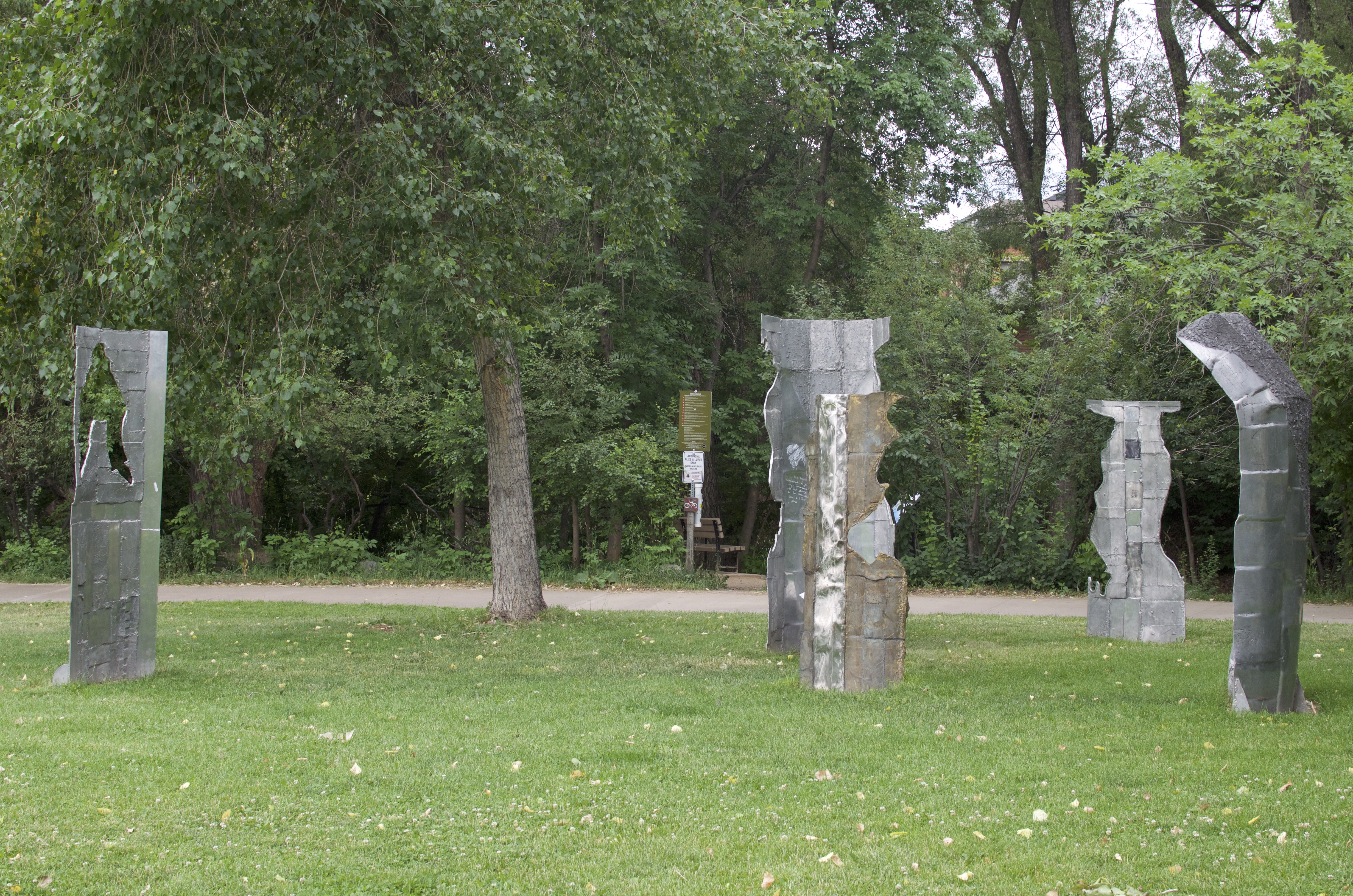
Title: Human Glyph Series
Artist: Bill Vielehr
Installation date: 2001
Materials: White bronze, manganese bronze, various aluminum alloys
Location: Haertling Sculpture Garden
In Boulder’s Charles A. Haertling Sculpture Garden, five free-standing steel sculptures circle one another, rupturing the sloping grass landscape with the cool-toned, gleaming, fragmented steel. Vielehr used the lost-wax casting technique to create and weld panels of white bronze, manganese bronze and various aluminum alloys. Vielehr employed his process-based style to translate two-dimensional drawings into three-dimensional art. When gazing upon the 3-D glyphs, the designs may remind viewers of cave paintings and hieroglyphics.
Vielehr honed his style during the 1960s deconstruction era of art, responding to the new techniques by creating sculptures or “3-D drawings” through obliterating, misusing, or making out-of-context the original images. Look closely: do you see the etchings and writing on the sculptures? This isn’t vandalism—the artist intentionally added those as part of his vision for the pieces as “3-D sketches.”
Bill Vielehr’s art oeuvre consists of steel sculptures, abstract human figures, and experimental drawings and reliefs. Although initially trained in classic figurative modeling techniques, Vielehr expanded his prowess by experimenting with cast and fabricated bronze and aluminum. For Vielehr, the process of abstracting figures or concepts is an ode to the handmade stereotype where art is not necessarily perfectly attractive or visually pleasing.
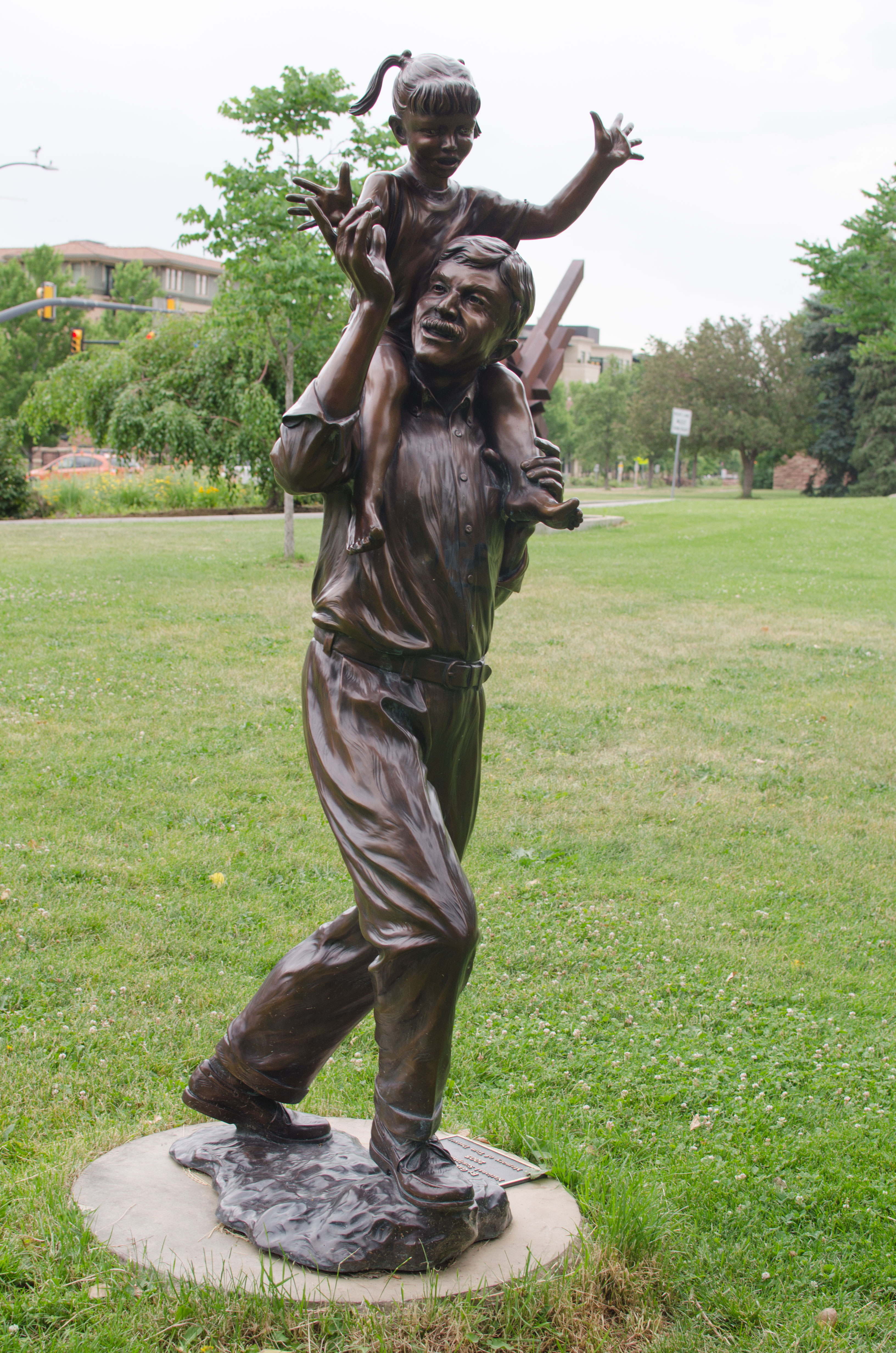
Title: Giddy Up
Artist: Gary Alsum
Installation date: 2005
Materials: Bronze
Location: Haertling Sculpture Garden
Embark on an emotive journey with "Giddy Up!" by Gary Alsum, a heartfelt bronze sculpture that captures a timeless moment of the joyous bond between a father and his daughter. This masterpiece depicts a barefoot little girl perched upon her father's shoulders, their expressions radiating pure happiness. Etched on the sculpture's base is a poignant dedication: "Giddy Up! By Gary Alsum / National Sculptors’ Guild / 2005 / In Memory of Tom Drever."
Gary Alsum, originally a skilled interior trim carpenter in Loveland, CO, transitioned into bronze sculpting, driven by his passion to celebrate the essence of life through art. Giddy Up! stands as a testament to Alsum's passion for capturing realistic human interactions across all ages and walks of life.
The realistically rendered Giddy Up! invites you to contemplate your own precious moments. Gary Alsum's dedication to craftsmanship and heartfelt storytelling shines brightly in every detail of this touching sculpture, promising to inspire and uplift all who encounter its charm. The Public Art Program seeks to add Giddy Up! to its collection due to the artistry and unique composition.
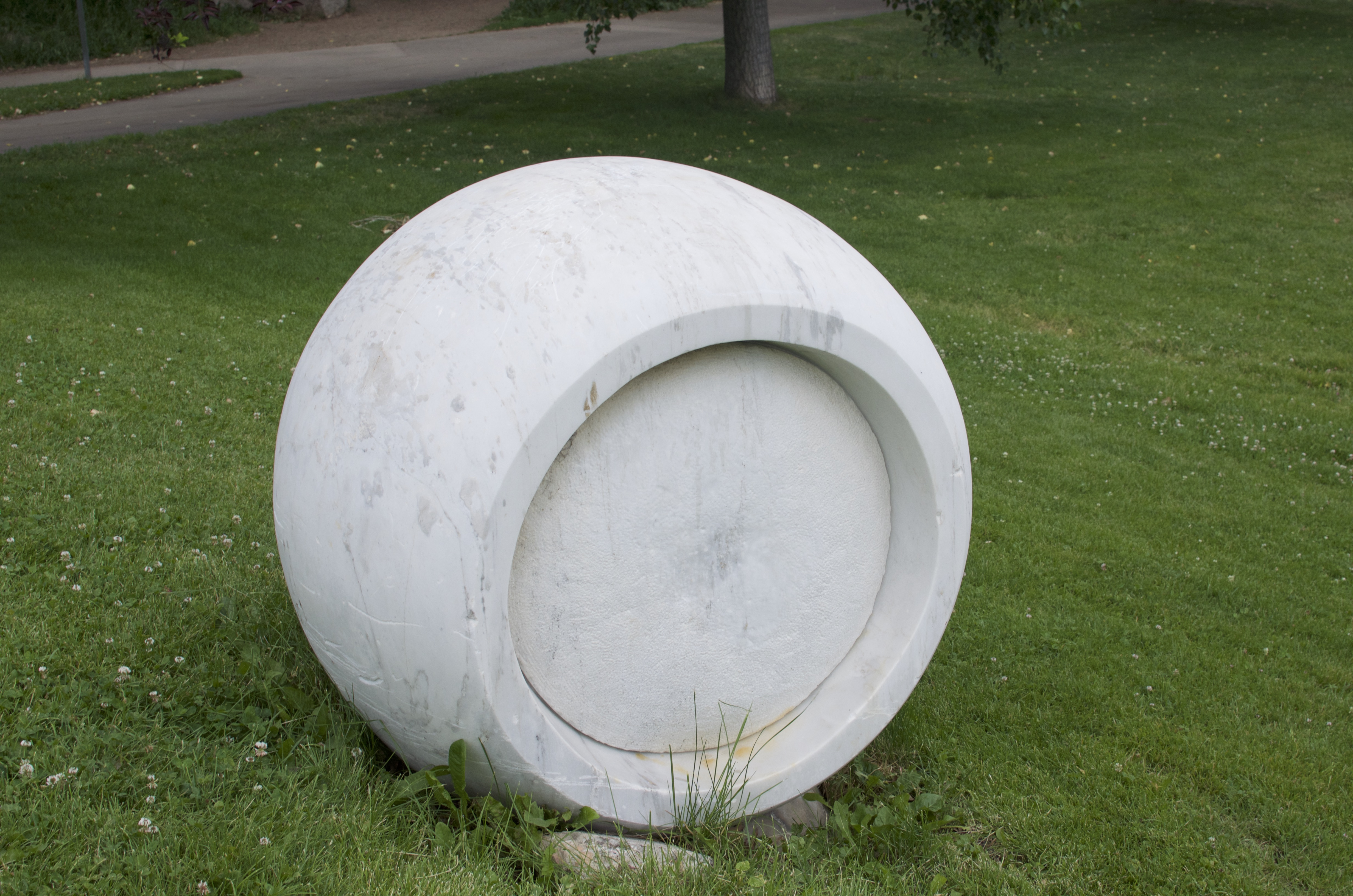
Title: Double Arc
Artist: Jerry Wingren
Installation date: 1987
Materials: Marble
Location: Haertling Sculpture Garden
While meandering up the hill towards 9th Street you will see Jerry Wingren’s Double Arc, installed in 1987. The spherical marble sculpture brings the modern, simplistic aesthetic popular in the 1960s to the sculpture garden. Each side of Double Arc is partially hollowed out, featuring an optical illusion of a spherical-like inset. The sculpture demonstrates Wingren’s interest and passion for mathematics found in nature – the muse to investigate the transformation between two-dimensional and three-dimensional planes.
Jerry Wingren’s educational background includes time spent at the University of Washington’s art school in 1959, and later, at the University of Bremen studying German drama. Whilst studying in Bremen, he discovered his passion for 3-D art by experimenting with timber. In Germany, he befriended and later apprenticed for two master sculptors, Otto Almstadt and Moritz Bohrmann, learning to sculpt with stone. Wingren continued practicing with 3-D art in Germany before returning to the U.S. where he worked with steel, marble, and granite. His inspirational styles include Scandinavian and Japanese aesthetics.
Wingren’s fascination with light and the passage of time, particularly during solstices and equinoxes, lends an ethereal quality to his work, inviting contemplation and wonder. As you look upon the sculpture, explore how light dances through its graceful curves, while discovering the enduring allure of Wingren's experimentation with form and space. Due to the unknown status of Double Arc’s initial donation, the artwork is not yet a part of the Public Art Collection.
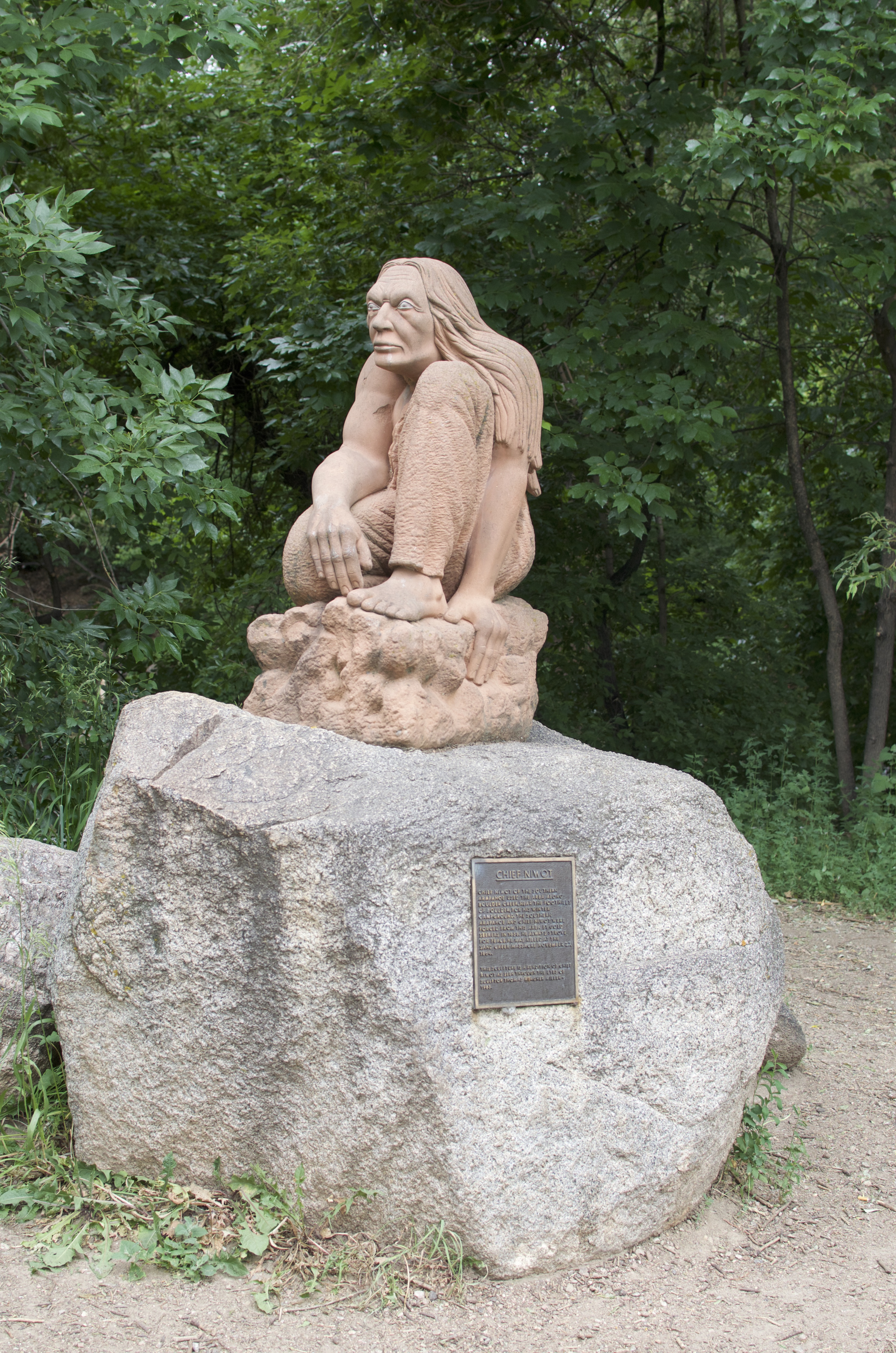
Title: Chief Niwot
Artist: Thomas Miller
Installation date: 1985
Materials: Sandstone
Location: Haertling Sculpture Garden
In 1985, Boulder County installed the 3-D work, Chief Niwot, sculpted by Thomas Miller. Miller used red sandstone to sculpt Chief Niwot who rests upon a natural, granite boulder. A plaque inlayed at the front of the boulder reads:
“Chief Niwot of the Southern Arapahoe used the area along Boulder Creek, near the foothills of Boulder, for his winter campground. The Southern Arapahoe and Chief Niwot were forced from this area by gold seekers in 1858. He always strove for peace. He was killed at the Sand Creek Massacre November 27, 1864.”
Take 9th St. underpass to stay on creek path
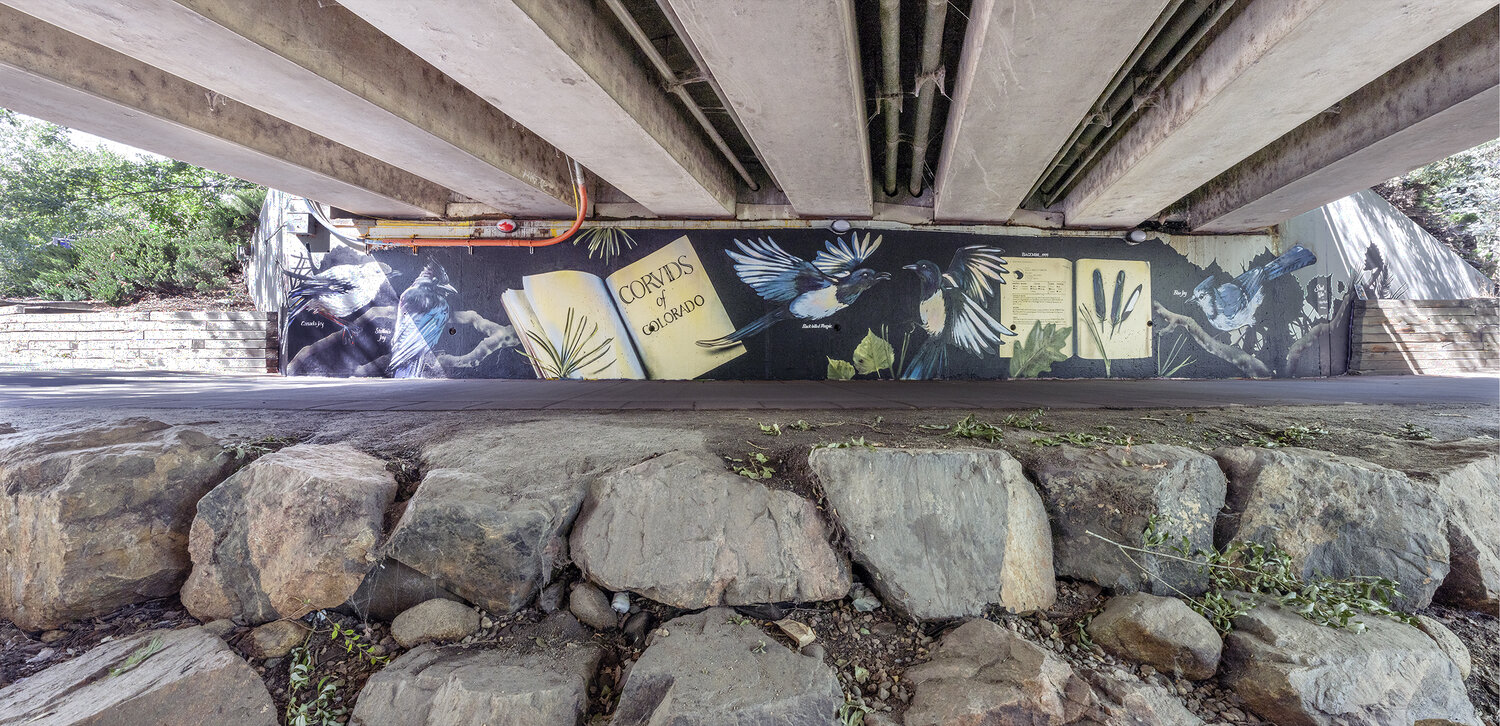
Title: Corvids of Colorado (Streetwise Mural)
Artist: Robert Martin
Installation date: 2020
Materials: Paint
Location: Creek path & 9th St. underpass
This mural is another one from Street Wise—not technically part of our collection, but a beautiful addition to the creek path!
Robert Martin's "Corvids of Colorado" mural reflects his upbringing in homes adorned with romanticized rural wildlife art. These works, depicting deer in snowy landscapes and pheasants in cornfields, are beloved in rural communities despite their exclusion from the traditional art canon.
Martin's mural celebrates Colorado's mountain birds with vibrant, flamboyant scenes, challenging the heteronormative assumptions of traditional wildlife art. By highlighting the fluidity and diversity of nature, he invites viewers, especially those marginalized by elitist art institutions, to appreciate the beauty and fragility of these avian populations.
The mural honors Martin's roots while reimagining them, creating a space where queerness and rural life coexist harmoniously, promoting awareness and inclusion through art.

Title: Diversity Supports the World
Artist: Ken Bernstein
Installation date: 2012
Materials: Ceramic tiles
Location: Under the Library, visible from creek path
To your right, visible across Boulder creek is Diversity Supports the World, a tile mural project which resulted from a decade-long journey of artistic collaboration and community spirit. Completed in 2012, Ken Bernstein partnered with Fairview High School students to create a symphony of individually colored tiled pillars and a mosaic wall beneath Boulder’s Main Library.
The imaginative design seamlessly integrates the beauty of Boulder’s flora and fauna into the urban landscape, creating a harmonious blend of art and environment. The relief elements of the tiles add depth and dimension, inviting tactile exploration and visual delight. Amidst the desert-inspired backdrop of the wall, a variety of subjects appear, from geometric shapes to human figures.
This community project showcases Bernstein’s ability to merge decorative art with functional design, enhancing both landscape and architectural settings. Diversity Supports the World stands as a testament to Bernstein's commitment to infusing natural elements into public spaces, enriching daily life with beauty and meaningful community expression. Due to the project’s purpose to enhance the library’s structure, the work is considered urban design.
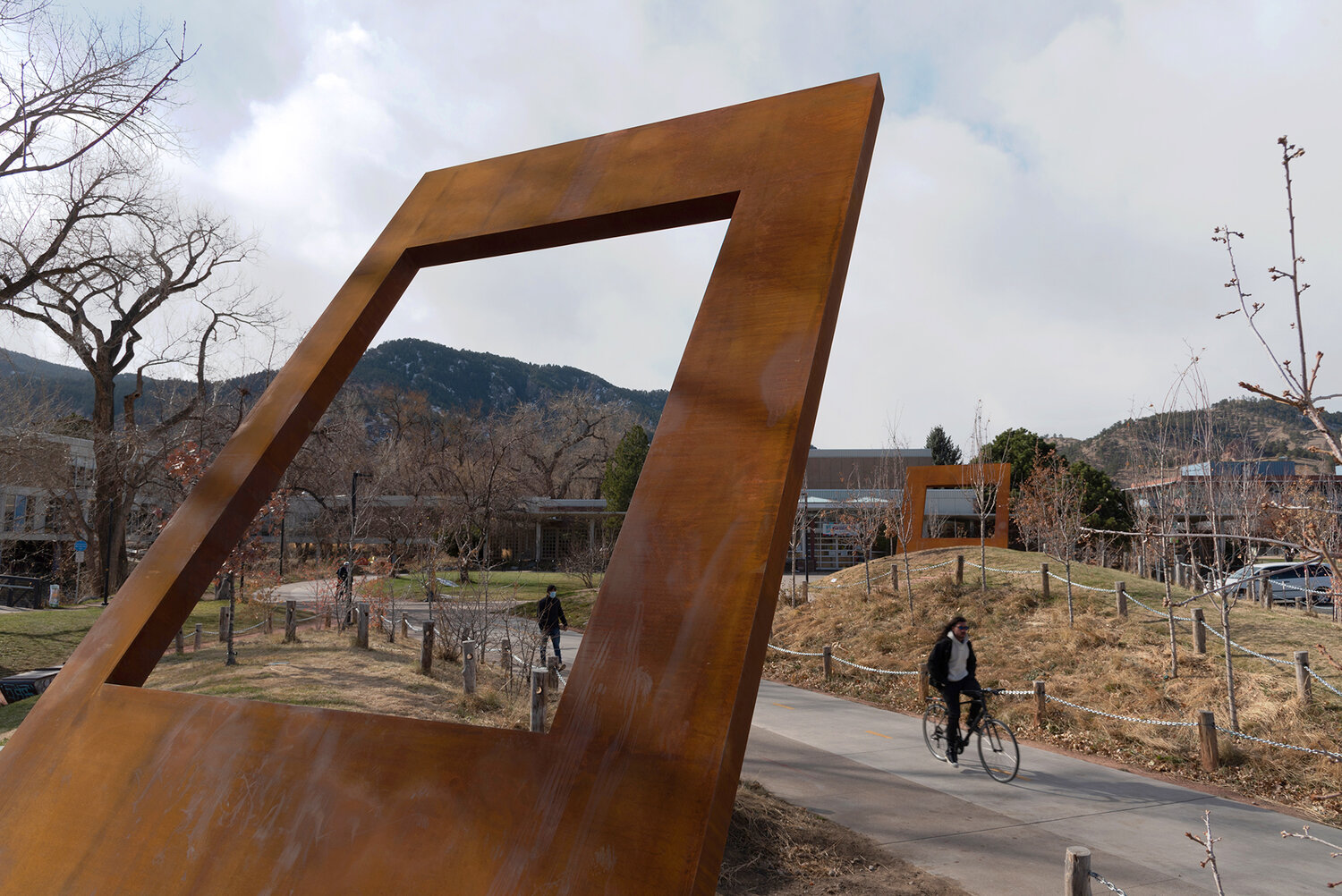
Title: Fifty Five Degrees
Artist: Adam Kuby
Installation date: 2020
Materials: Cor-ten steel
Location: East of Boulder Public Library
Adam Kuby designed and fabricated this piece for Boulder’s Civic Area. The artwork consists of three bronze monolithic frames which feature a unique, rectangular composition with an opening that acts as a window or a gateway. The openings frame views of the landscape, the skies above, or the mountains soaring in the distance beyond Boulder’s skyline. Kuby designed the site-specific sculptures to mimic the flatirons visible in the distance. 55 Degrees replicates the exact N-S axis orientation and the 55º slopes of the flatirons.
Adam Kuby creates site-specific artwork for commissions received across the globe. These artworks respond to environmental issues or interconnect with local landscapes. Adam Kuby’s background in landscape architecture, urban forestry, and zoo design informs his arts practice.
The 2018 redevelopment of this park was part of the 1% For Art policy, which gave the city the money to commission 55 Degrees.
Exit creek path and walk east on Arapahoe Ave. sidewalk toward Penfield Tate Municipal building
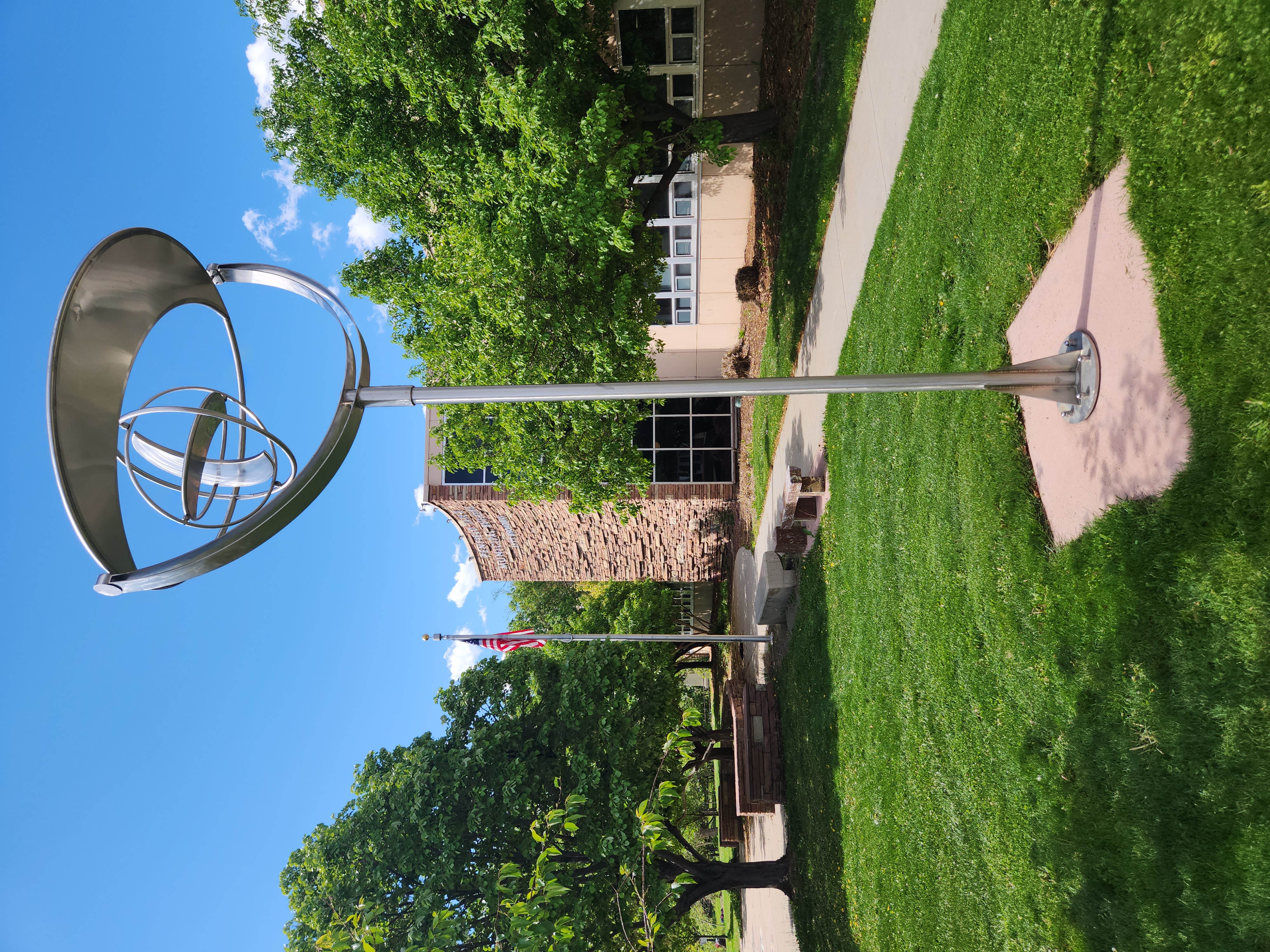
Title: A Search for Peace (Pilot and Navigator)
Artist: Charles Sturrock
Installation date: 2019
Materials: Stainless steel
Location: East side of Penfield Tate II Municipal Building
When walking along Canyon, near the Broadway intersection, a graceful kinetic steel sculpture, A Search for Peace, can be seen beside the Sister City Plaza. A Search for Peace, also known as “Pilot and Navigator,” was donated in 2019 to the City of Boulder by local Rotary member, Gordon Gamm. A Search for Peace was created for the Boulder Rotary Club’s Centennial Project, the “Infinite Walk of Peace.” The sculpture consists of four moving components: a crescent gyro representing a “Pilot and Navigator,” a crescent wing which represents the Rotarians’ craft, as well as a cradle and a post. The sculpture stands at 13 feet tall and has a ranging circumference between 6.5 and 11 inches.
The artist penned the following words to convey the spirit of the work as part of the Infinite Walk of Peace, honoring the Boulder Rotary Club’s Centennial Year: “As the wind moves the circles within circles in search of balance, the interplay of the wheels reflects our hope for peace in our hearts, peace in our homes, peace in our community, and peace throughout the world.”
The sculpture is located at the Sister City Plaza near Broadway and Canyon.
The “Infinite Walk of Peace” also includes five peace poles which provide the names of Boulder’s ten sister cities: Dushanbe, Tajikistan; Jalapa, Nicaragua; Kathmandu, Nepal; Kisumu, Kenya; Lhasa, Tibet; Manté, Mexico; Nablus, Palestine; Ramat HaNegev, Israel; Yamagata, Japan; and Yateras, Cuba.
Walk south to return to the Boulder Creek Path. Follow the path under the Broadway underpass. Turn right to cross the bridge.
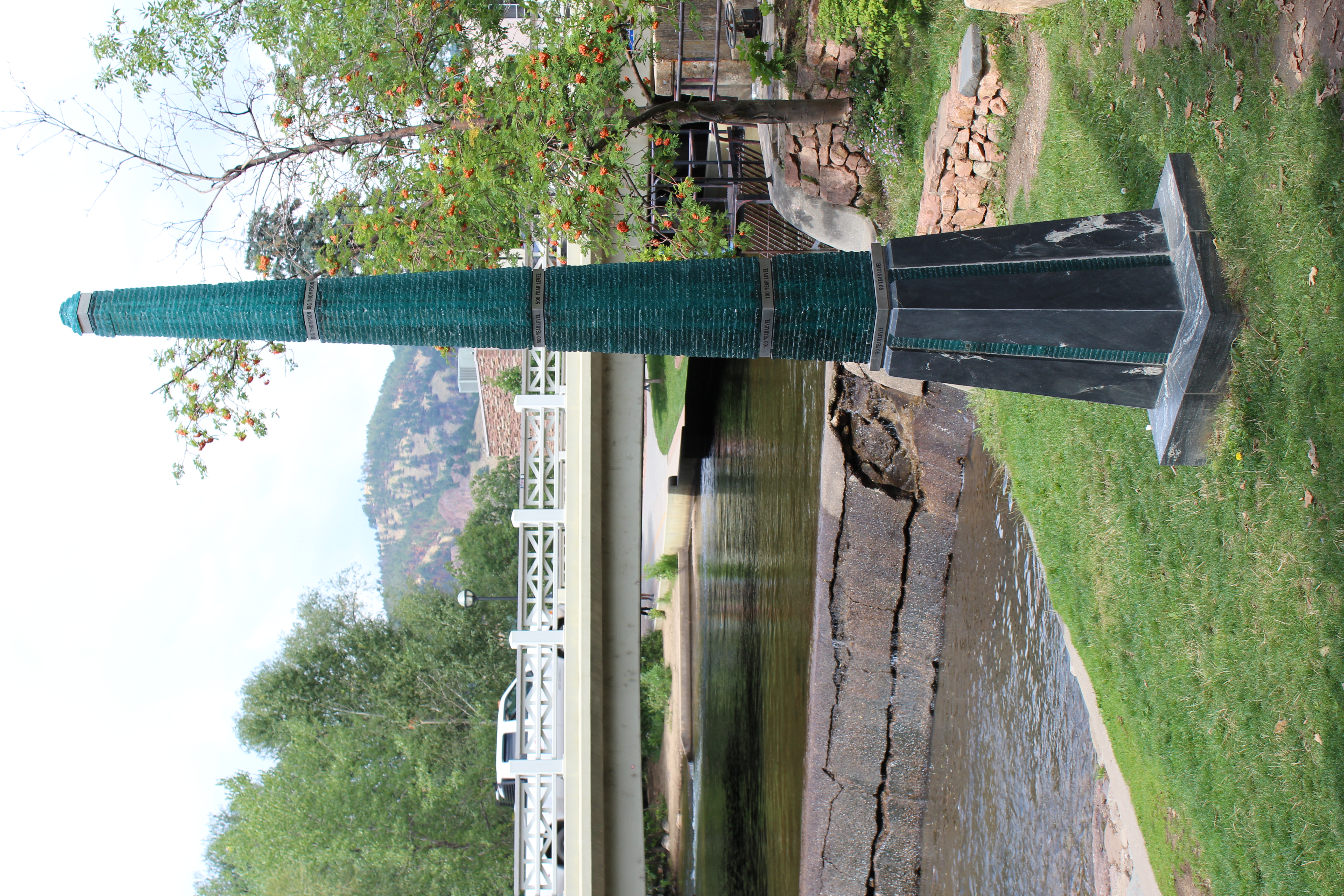
Title: Gilbert F. White Memorial Flood Level Marker
Artist: Mary White
Installation date: 2013
Materials: Recycled glass, steel, and stone
Location: Boulder Creek Path, east of Broadway underpass
Rising from the sloping bank along Boulder Creek is the glistening, aqua-colored Gilbert F. White Memorial Flood Level Marker. This six-year collaborative masterpiece, by Mary White and Christian Muller, was unveiled on July 17, 2011 during a dedication ceremony. The monumental obelisk shimmers brightly with its recycled glass, weighing around 1450 lbs., supported by steel and stone. The obelisk serves as a poignant reminder of the local flood risks within Boulder County.
To add an educational element to the memorial, White included 50, 100, and 500 level markers on the glass surface. The fourth inscription, located near the top of the obelisk, is the 1976 Big Thompson flood marker that equaled a 1000-year flood level of 16 feet. Water gushing through Big Thompson canyon on July 31, 1976 claimed 144 lives and decimated numerous homes throughout the area. White purposed the marker to bring awareness to local flooding and the need for emergency preparedness.
Mary White's journey as an artist began in the Bay Area, where she cultivated her sculpting skills whilst passionately educating students about art in tandem with flood mitigation strategies. The memorial obelisk embodies her dedication to raising awareness of critical ecological issues such as renewable energy, water conservation, and urban wildlife habitats. White's commitment to sustainability is evident in her choice of using salvaged materials, embodying her environmentally friendly approach to artmaking.
For the Gilbert F. White Memorial Flood Level Marker, art meets advocacy in a powerful testament to community resilience and environmental stewardship. Explore the intricate details and profound narrative woven into this monumental sculpture, inviting reflection on our shared responsibility to protect and preserve our natural surroundings.
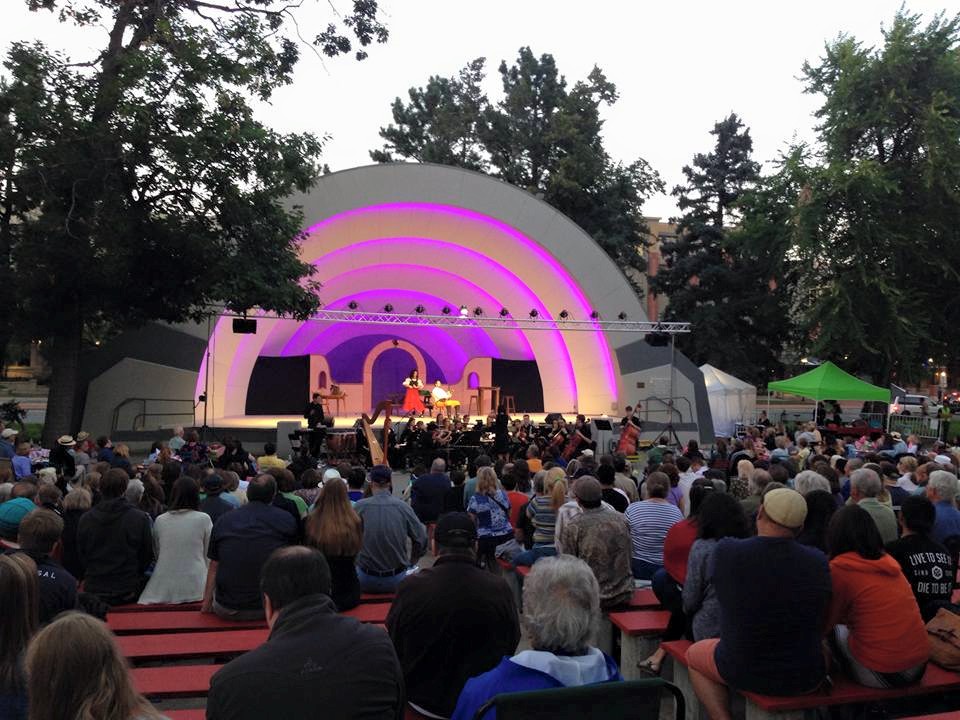
Glen H. Huntington Bandshell
The Glen H. Huntington Bandshell, named after the structure’s architect, has been a fixture in downtown Boulder’s Central Park since 1938. The bandshell has been a place of community pride, public gatherings, and civic events. This structure is one of two remaining bandshells from the early to mid-1900s and remains as one of the few examples of Art Deco architecture in Boulder. Due to its historic significance, the bandshell received landmark status in 1995 to ensure it remains for years to come.
Being born in Denver guided Huntington’s choice in education and later, his career path, all based in Colorado. Huntington pursued studies in Civil Engineering from the University of Colorado. After graduating, Boulder became his homebase for his practice after World War I. Architectural projects throughout his career include churches, houses in University Hill and Chautauqua Heights, the Boulder County Court House, and Boulder High School. Glen H. Huntington continued the architectural legacy of his father, Glen W. Huntington, who is remembered for his designs of single-family homes and public structures in Denver.
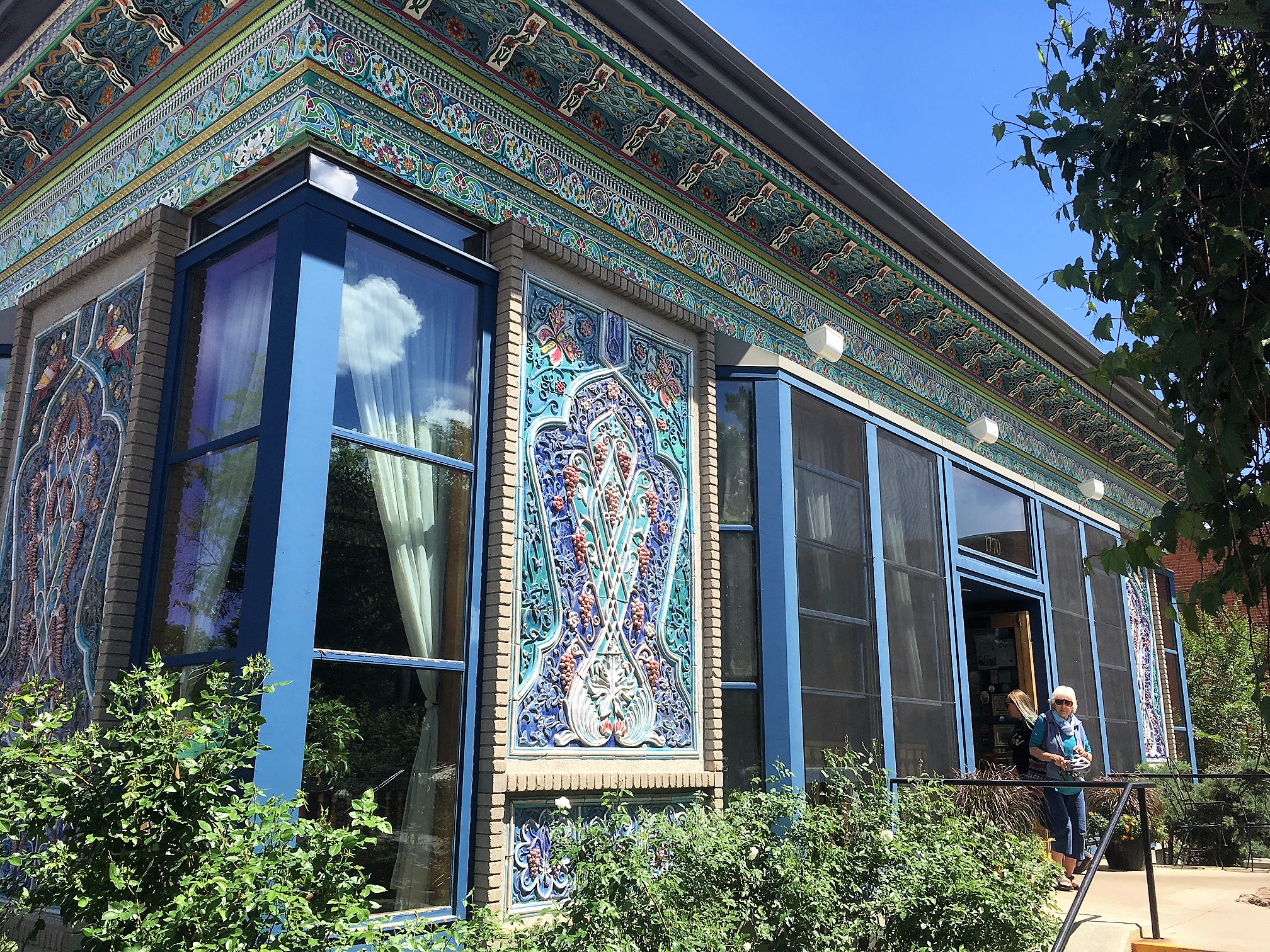
Dushanbe Teahouse
In 1987, during his first visit to Boulder, Mayor Maksud Ikramov announced that Dushanbe planned to present Boulder with a Teahouse to celebrate the establishment of sister city ties. From 1987-1990, more than 40 artisans in several cities of Tajikistan created the decorative elements of the Teahouse, including its hand-carved and hand-painted ceiling, tables, stools, columns, and exterior ceramic panels. Often these skills are handed down from generation to generation within families. Lado Shanidze served as chief architect.
After creating the teahouse in Dushanbe, the structure was dismantled, shipped, and reassembled at its location along 13th Street near the Civic Area. Two master woodcarvers, Manon Khaidarov and Mirpulat Mirakhmatov, supervised the reassembly operation and then celebrated the building’s completion by carving their names into the wood panel ceiling. If you take the time to encounter the magnificence of the teahouse, make sure to survey the ceiling, looking for their signatures.
As you wander around the exterior or the interior, reflect upon the magnificence of the Dushanbe Teahouse which is the product of a 2,000 year old tradition of woodcarving, cultural practices, and Middle-Eastern design. Appearing throughout the building are traditional Persian designs which involve nature motifs as well as the repetition of patterns.
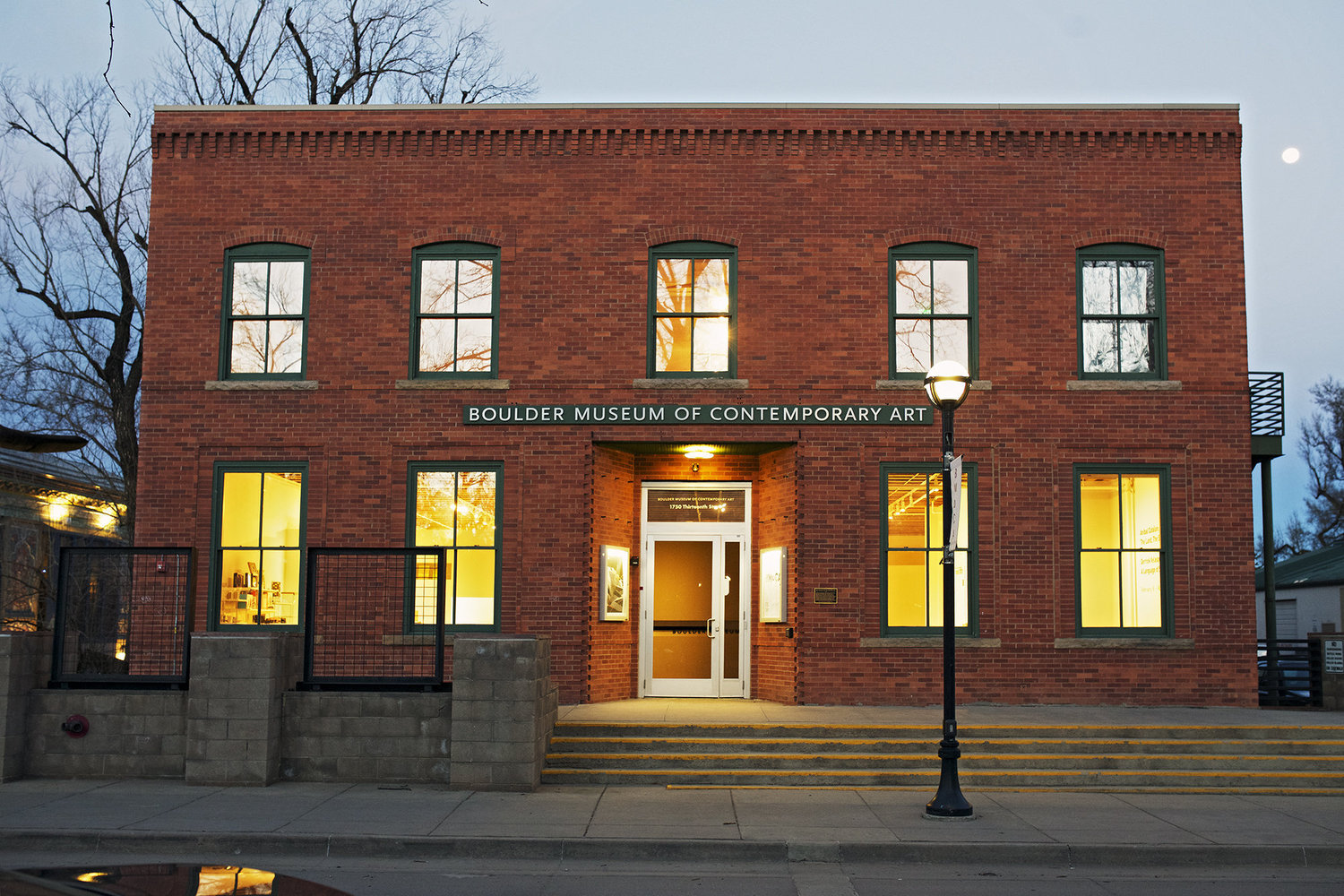
Boulder Museum of Contemporary Art (BMoCA)
To the right, just beyond the Dushanbe Teahouse along 13th Street is the Boulder Museum of Contemporary Art (BMoCA). In 1972, artists founded the art institution to provide a physical space for locals to commune and exhibit their work. BMoCA’s status as “non-collecting” guides its mission to display contemporary artists by frequently rotating the exhibitions.
BMoCA’s current structure is another cornerstone of Boulder’s architectural history through its designation as a 1906 historic landmark building. Due to the building’s age and its inability to be altered, certain artworks cannot be supported if they exceed entryway dimensions or the max-load capacity for the floors. BMoCA is in the process of designing and constructing a new campus which includes gallery spaces that can support heavier or oversized pieces. The art institution attracts over 100,000 visitors annually and presents inclusive, free access educational programs in six counties as well as exhibitions at six satellite locations.